#cause it’s been ~200 years they *have* to be part of the new ecosystem
Explore tagged Tumblr posts
Text
Anyone else ever think about how all the post apocalypse creatures would have to be a part of the new ecosystem and what it’s doing to it when people kill a ton of them?
#no fandom#although I am thinking about all the irradiated bugs and animals in fallout#cause it’s been ~200 years they *have* to be part of the new ecosystem
9 notes
·
View notes
Text
Governments appear to have signed a once-in-a-decade deal to halt the destruction of Earth’s ecosystems, but the agreement seems to have been forced through by the Chinese president, ignoring the objections of some African states.
After more than four years of negotiations, repeated delays due to the Covid-19 pandemic and talks into the night on Sunday in Montreal, nearly 200 countries – but not the US or the Vatican – signed an agreement at the biodiversity Cop15, which was co-hosted by Canada and China, to put humanity on a path to living in harmony with nature by the middle of the century.
In an extraordinary plenary that began on Sunday evening and lasted for more than seven hours, countries wrangled over the final agreement. Finally, at about 3.30am local time on Monday, news broke that an agreement had been struck.
The Democratic Republic of the Congo’s negotiator appeared to block the final deal presented by China, telling the plenary that he could not support the agreement in its current form because it did not create a new fund for biodiversity, separate to the existing UN fund, the global environment facility (GEF). China, Brazil, Indonesia, India and Mexico are the largest recipients of GEF funding, and some African states wanted more money for conservation as part of the final deal.
However, moments later, China’s environment minister and the Cop15 president, Huang Runqiu, signalled that the agreement was finished and agreed, and the plenary burst into applause.
Negotiators from Cameroon, Uganda and the DRC expressed incredulity that the agreement had been put through. The DRC said it had formally objected to the agreement, but a UN lawyer said it had not. The negotiator from Cameroon called it “a fraud”, while Uganda said there had been a “coup d’état” against the Cop15.
Amid plummeting insect numbers, acidifying oceans filled with plastic waste, and the rampant overconsumption of the planet’s resources as humanity’s population grows wealthier and soars past 8 billion, the agreement, if implemented, could signal major changes to farming, business supply chains and the role of Indigenous communities in conservation.
The deal was negotiated over two weeks and includes targets to protect 30% of the planet for nature by the end of the decade, reform $500bn (£410bn) of environmentally damaging subsidies, and restore 30% of the planet’s degraded terrestrial, inland water, coastal and marine ecosystems.
Governments also agreed urgent actions to halt human-caused extinctions of species known to be under threat and to promote their recovery.
The deal follows scientific warnings that humans are causing the start of Earth’s sixth mass extinction event, the largest loss of life since the time of the dinosaurs.
5 notes
·
View notes
Text
Earth slowed down dramatically during worst ever mass extinction, Chinese-led study finds

Two major shifts in the speed the world spins round were found – one during the Great Dying and the other during a sudden explosion of life
The speed at which the world spins round slowed dramatically twice hundreds of millions of years ago, with one time coinciding with the biggest mass extinction event, according to new research.The other incident happened during a rapid expansion of life on Earth known as the Cambrian explosion, the Chinese-ledteam concluded. Although the world seems to rotate at a constant pace, the exact timing can vary and is not precisely 24 hours. Changes in gravity caused by variations in the distance between the moon and the Earth are known to cause ocean tides, but the friction between the tides and the Earth’s surface also causes a slight deceleration in its rotation. At the same time, Earth transfers momentum to the moon, causing it to gradually move outward. According to the study, the Earth’s rotation has been decelerating due to this phenomenon throughout its history but this rate has varied over time. After two years of analysis the team, led by Ma Chao from the Institute of Sedimentary Geology at Chengdu University ofTechnology, concluded that between 700 million and 200 million years ago, the distance between Earth and the moon increased by around 20,000km (12,000 miles), causing the length of the day to increase by about 2.2 hours. The team, which also included astronomers from France and geologists from Germany and Ireland, found that Earth’s rotational deceleration is not a smooth process but includes periods of rapid deceleration followed by intervals of stability. “Specifically, there are two intervals with pronounced Earth rotation deceleration: between 650 and 500 million years ago(Mya), and between 350 and 280 Mya, separated by a period of stalled deceleration from 500 to 350 Mya,” the team wrote in a paper published in the Proceedings of the National Academy of Sciences this month. The first shift coincided with the Cambrian explosion, when complex life forms rapidly diversified, including the ancestorsof many modern species. Recent research has linked this event to changes in the composition of seawater, mainly the removal of harmful ions, which made oceans more habitable. The second shift, around 250 million years ago, coincides with the “Great Dying”, an event also known as the Permian–Triassic extinction event, which wiped out 90 per cent of life on Earth. Ma linked the changes in sea conditions to the sudden shift in the Earth’s rotation, telling Science and Technology Daily: “The two major ‘fast-slow’ deceleration periods may have provided the necessary conditions for the early evolution of marine ecosystems.” Scientists already believe that specific geological processes may be related to changes in the Earth’s rotation and are looking for possible links. “For example, changes in the length of the day may influence the distribution of solar energy and temperature gradients, potentially impacting weather systems and atmospheric dynamics,” the team wrote in the paper. “This study holds significant theoretical importance for reconstructing the evolutionary history of the Earth-moon system and exploring climatic, environmental and biological evolution related to Earth’s rotational deceleration,” Ma concluded.
We are thrilled to extend a warm welcome to the China Scientist Awards!
Join us for the China Scientist Awards, a premier event in the realm of research. Whether you're joining virtually from anywhere in the world, this is your invitation to explore and innovate in the field of research. Become part of a global community of researchers, scientists, and professionals passionate about advancing research
.visit: chinascientist.net Nomination Link: https://chinascientist.net/award-nomination/?ecategory=Awards&rcategory=Awardee Registration Link:https://chinascientist.net/award-registration/ For inquiries, contact us at [email protected]
-------------------------------------
Other website:https://x.com/ChinaSciAwards
https://in.pinterest.com/chinamails123/
https://www.instagram.com/cs_chenguang/
https://www.facebook.com/profile.php?id=61560863696916
https://www.youtube.com/channel/UCOwukWCIjAyH-UgH-larrsA
0 notes
Text
Exploring Opportunities for Climate Tech Venture Capitalists with Green Frontier Capital
The Rise of Climate Tech VCs. The most serious issue with climate change is not climate technology; it is human psychology. Climate change is one of the most difficult challenges to handle due to our inability to comprehend the severity of these difficulties completely, appreciate their long-term repercussions, and deal with the adjustments that must be made at all levels of society. “Many individuals believe that climate change is a distant concern. Distant in time, that this problem will not be felt for a long time, distant in space, that it is about Polar Bears or maybe some emerging countries. — Anthony Leisorowitz, Director of the Yale Program for Climate Change Communication
Climate change’s consequences must be recognized as both immediate and ongoing. It impacts ecosystems, economies, and societies all across the planet. Climate scientists have demonstrated that human actions have been at the root of all global warming over the last 200 years. The primary causes of this have been industrialization, deforestation, agricultural operations, and reliance on fossil fuels. In response, climate tech investment and entrepreneurship have increased in recent years. Several green projects are underway in several areas to develop new solutions to reduce greenhouse gas emissions and promote sustainable behaviors. According to Deloitte’s (2023) research, climate tech enterprises operate in over 65 nations. But they are concentrated in eight nations, one of which is India. These eight countries have a significant effect on climate technology investment. Green Frontier Capital is spearheading the effort in India for just this reason. The purpose is to promote green investments and sustainable finance to give investors profits that do not harm the environment, as well as to encourage decarbonization.
Climate Tech Investments in India In 2019, India ranked seventh among countries most affected by climate change. According to the figures, the average temperature in India climbed by almost 0.7 degrees Celsius between 1901 and 2018. According to a recent collaborative research conducted by IIT-Kharagpur and IITM-Pune, India’s temperature is anticipated to rise by an average of 1.1 to 5.1 degrees Celsius by 2100 as a result of different greenhouse gas emissions. As a result, regions of the country are facing drought, lower rainfall, and more frequent extreme weather events. These changes jeopardize not just food production and water supply, but also have far-reaching consequences for both economic and ecological systems.
According to the World Bank, India would face a serious health crisis, with rising malnutrition and linked health issues such as child stunting. The poor are likely to be the most affected. Child stunting is expected to rise by 35% by 2050 when compared to a scenario without climate change.
Climate tech venture capitalists play an important part in this, and the emergence of green investments that address climate change and promote sustainability is a true silver lining. According to FSG, climate tech investments in India increased by 29% from 2019 to 2022, with a record-breaking investment topping US$5 billion in 2022. The surge in investments demonstrates not just a chance for investors to earn a solid return, but also the emergence of a melting pot of new ideas from Indian creators to handle the multitude of difficulties that lie ahead. Green Frontier Capital is India’s first climate VC fund, concentrating on sustainable finance through investments in renewable energy, clean transportation, waste management solutions, and agritech.
VCs Have Branded Climate Tech as the Fourth Investment Era of India. Green Frontier Capital believes that the next decade will be a new investment era driven by green investments and climate technology, following liberalization in the 1990s, the internet in the 2000s, and mobile in the 2010s. Climate tech venture capital, such as Green Frontier Capital, may give entrepreneurs financial support, knowledge, and networking opportunities, therefore promoting development and effective innovation.
Green Frontier Capital’s green investments include Chupps, a sustainable footwear brand that sells to hundreds of thousands of customers per month, ElectricPe, the country’s leading EV charging platform, and BluSmart, India’s first and largest zero-emission ride-hailing service platform. The opportunity for profitable and beneficial investments awaits. And climate tech VCs and investors don’t need to look much further. India’s climate technology industry has the potential to make a big contribution to tackling the climate catastrophe while also fostering long-term economic prosperity.
Tags: climate investors India | Top climate tech vcs | Venture capital funds | Green investments in India | top investment companies in India | Venture Capital for Startups
0 notes
Text
Yk that pirates and seafarers put goats on the Galápagos Islands way back when, incase they got stranded? bc they were left for so long, their population grew out of control (they were an invasive species) . they damaged crops and rare plants only native to the islands. so they were causing issues, obviously.
so how did the conservationists fix the goat problem?
air strikes from attack helicopters. basically, they gunned em down until there were too few to find easily. but they weren't all gone, so yk what the conservationists did next?
judas goats. they tagged some goats, sterilised them too, and set them free. and bc goats are sociable, they'd go off and find a trip (group of goats). a few days later, they'd find the goat in this new trip, kill the other goats, then send the tagged one on its way to find a new trip.
that has to be bad for the poor goats right? yeah, yeah it was. the goats would experience trauma from the sound of the guns, and anxiety because they came to associate the sound with the death of animals they formed bonds with. capture and handling could also cause anxiety. repeated isolation could cause even more.
but did it work? yes. the plant life and animals that we thought had gone excinct because of the goats reappeared. the ecosystem bounced back really well.
what happened to the judas goats? the over 200 of them on Isabela were allowed to remain on the island for the rest of their lives as there was no chance of them reproducing (they had been sterilised as part of the prep for them to become judas goats). the carcasses of the other goats, while some were taken by locals living on the islands, were mostly left to decompose (not bad for the ecosystem, there was a huge amount of them too, too many to move).
sources: (i can't link multiple in the source tab :c)
(thanks to Caroline Roper on episode 6 of 'let's learn everything' for sharing this, I love listening to the show sm and enjoyed learning about this)
episode:
(sorry for the info dump, I can't stop thinking about this, so I'm screaming into the endless oblivion of tumbr where no-one will hear me lol)
#I have completed feelings on this#I understand that something had to me done#But a cull seems extreme#But also#There were very few other options#And the others were all far too expensive to be viable#Sometimes conservation means culling#I guess#invasive species#conservation#galápagos#goat culling#goat#goats#All in all#I dont blame the conservationists#They did what they had to#Still tho#The poor judas goats#Judas goats
1 note
·
View note
Text
SACRAMENTO, Calif. (AP) — California Gov. Gavin Newsom's administration said Thursday it will now cost more than $20 billion to build a giant tunnel aimed at catching more water when it rains and storing it to better prepare for longer droughts caused by climate change.
State regulators have been trying to build some version of a water tunnel system for decades. The latest form championed by the Democratic governor is a single giant tunnel, down from two tunnels proposed by his predecessor, Jerry Brown. Newsom's administration says the state can capture more water from the Sacramento River during major storms and send it south for storage.
The last cost estimate, which came in 2020, put the price tag for a single tunnel project at $16 billion. The new analysis says the tunnel will cost $20.1 billion, an increase they attribute almost entirely to inflation, which soared after the pandemic.
The project would be paid for by 29 local public water agencies, who get their money from customers.
The analysis, conducted by the Berkeley Research Group but paid for by the state, said the tunnel would yield $38 billion in benefits, mostly because of an increased water supply that would be better protected from natural disasters like earthquakes.
“The benefits clearly justify the costs,” said David Sunding, emeritus professor at the University of California, Berkeley who led the analysis.
Despite that rosy outlook, the tunnel remains one of the most controversial projects in recent memory. Environmental groups say its construction would have devastating impacts on the already vanishing ecosystem of the Sacramento-San Joaquin River Delta, the largest estuary on the West Coast that is home to endangered species of salmon and other fish.
The analysis released Thursday notes the environmental impacts include lost agricultural land, reduced water quality in the Delta, and impacts on air quality, transportation and noise.
“Instead of foisting the costs of this boondoggle project onto Californians, the state should invest in sustainable water solutions that promise to restore the Delta ecosystem, not destroy it," said Barbara Barrigan-Parilla, executive director of the environmental advocacy group Restore the Delta.
State officials note the project now includes $200 million for grants to fund local projects in areas impacted by construction.
Beyond environmental concerns, the project has become a political landmine throughout the Central Valley's farming communities, where it is seen as yet another attempt by Southern California to steal their water. While most of California's population lives in the southern part of the state, most of the state's water comes from the north. In the state Legislature, lawmakers have blocked any effor t to benefit or speed up the tunnel's construction.
"This new analysis acknowledges what we’ve known all along: the Delta Tunnel is meant to benefit Beverly Hills and leave Delta communities out to dry,” said U.S. Rep. Josh Harder, a Democrat whose district includes the Central Valley communities like Stockton, Lodi and Galt. "I’m sick and tired of politicians in Sacramento ignoring our Valley voices and I will do everything in my power to stop them from stealing our water.”
The tunnel would be part of the State Water Project — a complex system of reservoirs, dams and canals that provides water to 27 million people while irrigating 750,000 acres (303,515 hectares) of farmland.
Climate change is threatening that supply. A recent drought saw the three direst years on record, which dropped reservoirs around the state to dangerously low levels and prompted mandatory rationing and even caused some hydroelectric power plants to shut down. State officials predict that by 2070 State Water Project deliveries will decline by 22% because of climate change.
The proposed tunnel would be about 45 miles (72 kilometers) long and 36 feet (11 meters) wide, or large enough to carry more than 161 million gallons of water per hour. State officials say this tunnel would let the state capture more water when the state is hit by “atmospheric rivers” — large storms that can drench the state for weeks during the rainy season.
The analysis released Thursday says the tunnel would increase water deliveries by about 17%, nearly accounting for the anticipated decline because of climate change.
“There is a very real cost to do nothing. It is vastly more efficient and economical to avoid declining supplies," said Karla Nemeth, director of the California Department of Water Resources. “Water shortages, mandatory restrictions, land fallowing and job loss all impact our state and local economies.”
1 note
·
View note
Text

The Future is Wild - film review
The Future is Wild was the brainchild of a team of animators, wildlife photographers, and scientists to construct what the world will look like 5 million, 100 million, and 200 million years from now. The first step was to consult geologists to predict how continents will continue to move based upon how landmasses have moved in the past. Next, climatologists built the plants and ecosystems onto the future maps. Biologists completed the picture by pairing flora with the fauna based on how species have evolved in the past to world changes. The result is disorienting, surprising, and occasionally disturbing. Rule one was that the human species is extinct. Five million years seems far enough to assume this is the case. People are rapidly losing their adaptive skills thanks to a combination of overpopulation beyond resources and increasingly rigid social systems. Herein lies the fascinating part: what happens once humans are out of the picture?
Five million years from now, the advancing ice age has decimated the rain forests. The animals resemble what inhabits the world today, with some adaptations. Mammals still dominate the surface, though predatory birds have taken over the savannah. Volcanic eruptions become common, and the planet warms up.
One hundred million years from now, the planet is steamy, and the air is packed with carbon dioxide and oxygen. The animals have become huge compared to their modern day equivalents; insects are measured in meters. The atmosphere is volatile, and the Earth’s lava core even more so. At the end of this period, massive pan-global volcanic activity fills the skies with ash and carbon dioxide for a couple of decades. This is a relatively brief period, but enough to kill the phytoplankton in the oceans and decimate the land plants, which in turn causes mass extinctions of virtually anything large and/or unable to survive on minimal food intake until the sunlight returns and the plants and plankton rebound in numbers. Life is challenged periodically by these catastrophic events to come up with a solution rather quickly, and some lifeforms can adapt to survive a lack of food, sunlight, or drastic changes in the weather. After these events, such as the meteorite strike that killed the dinosaurs, or the massive land devastation caused by human industry, the organisms that remain proliferate, and continue to adapt to the new circumstances.
Two hundred million years from now, nearly all life has been wiped out, and the survivors evolve into increasingly bizarre creatures like terrestrial squid the size of elephants, and sharks equipped with neon directional signals for hunting purposes.
Each snapshot places you in the center of predator-versus-prey relationships that have been ongoing for millennia, and as such hold a unique tension. The action is raw, and proceeds without a shred of sentiment. Giant airborne insects armed with razor sharp forelegs spear birds in flight, monkeys fall prey to giant meat-eating birds, and massive intelligent squid are torn to ribbons by swift moving sharks. All species are doomed to extinction, and perhaps the process of life itself is doomed. They – we – only exist for a brief period. Perhaps one species will have an adaptation that will allow it to be one of the few to survive a cataclysm, and life is allowed to exist for another millennia.
One episode in particular struck a nerve, taking place 100 million years from now. Spiders work to weave giant webs that span an entire canyon, the purpose of which is to collect… seeds. Strange. The spiders amass hills of seeds in their cavernous nests, but spiders are carnivores. Out of the shadows emerges a small rodent. Whilst surrounded by carnivorous spiders, these mice-like creatures eat the seeds, occasionally being killed and eaten by the spiders. The mice are being farmed, you see. The rodent presented here is the last mammal on earth, reduced to hiding in a cave, livestock for a spider colony. Having slowly lost the competition for resources to birds, reptiles, and insects, the mammal is to be the first major group to vanish. This seems sensible, as mammals are one of the fastest-disappearing groups anyway, occupying most of the spots on the International Union for Conservation of Nature’s endangered species listing. Currently, the pace of extinctions of plants, amphibians, and mammals are at their greatest since the Cretaceous period, all due to human action.
Humanity going extinct would hardly be the worst thing to happen to the planet. Nonetheless, it gave me a chill to think that any animal that even resembles us would be wiped off the face of the earth. This affords a unique chance to come to terms with one’s own morality in the grandest existential way. Every form of life has a desire to preserve and perpetuate, and the human race is no exception. This, however, is the uncompromising world, and nature is ruthless. Among its many strengths, it is this calmly combative reality check that The Future Is Wild does best of all.
1 note
·
View note
Text

Makkah, Saudi Arabia 🇸🇦! Muslim pilgrims at the Grand Mosque. Photograph: Mohamed Abd El Ghany/Reuters

London, England 🏴! A detail from a jumper worn by Diana, Princess of Wales that is predicted to sell at auction for up to £70,000 at Sotheby’s in New York in September. Photograph: Sotheby’s/PA
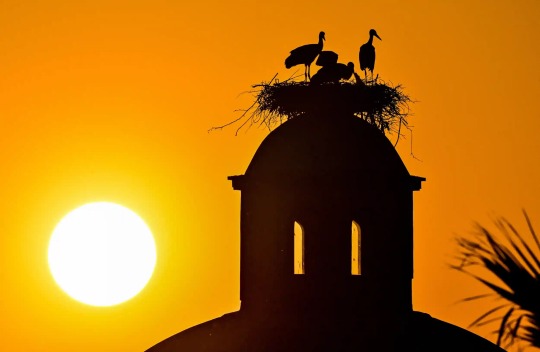
İzmir, Turkey 🇹🇷! Storks nest on the top of a building at sunset. Photograph: Anadolu Agency/Getty Images
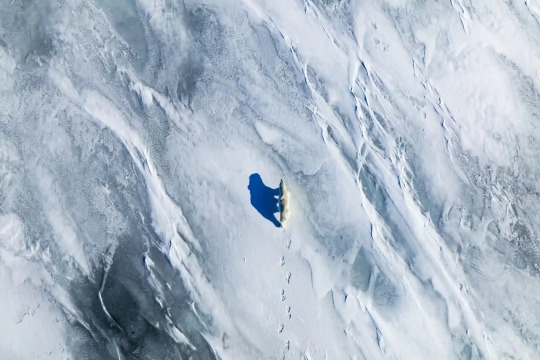
A giant male polar bear walks on the thin ice during late spring in Svalbard. The sea ice area on Svalbard is getting smaller and smaller each year, with the area warming seven times faster than the rest of the World
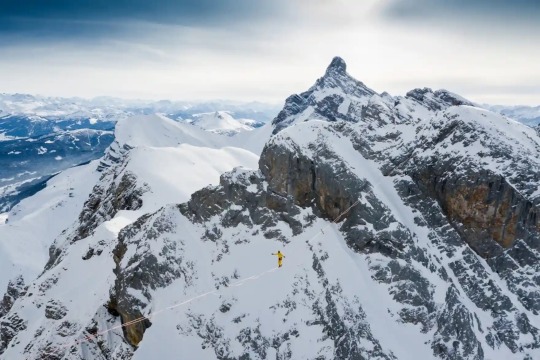
In January 2021, amid intense cold, the renowned tightrope walker Nathan Paulin successfully crossed a 200-metre long and 2.5cm wide highline at Pointe d’Areu in the Aravis range, at an altitude of 2,460 meters. This incredible achievement required the dedicated efforts of a team of six people over the course of three days to execute this world premiere

A bird’s eye view of a group of buffalo dipping in a pond to cool off on a hot sunny midday. The contrasting colours of the buffalo and their surroundings created an eye-catching earth-toned image.

A 14th-century church tower in Italy stands as a poignant reminder of the sunken village of Curon Venosta. In 1950, the entire village was submerged following the construction of a dam, resulting in the creation of the artificial basin known as Lake Resia. Today, only the church tower remains.
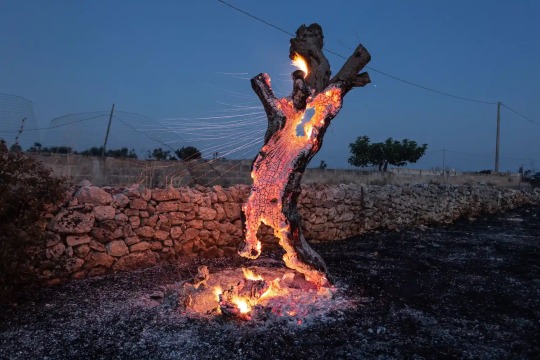
Filippo Ferraro, Wooden Diamonds! A burning trunk of an olive tree in the countryside near Felline, Italy. Since the beginning of this epidemic (when the plant bacterium Xylella fastidiosa began infecting olive trees), thousands of fields have been abandoned, causing a significant increase in fires, especially with the high temperatures of the summer. Photograph: Filippo Ferraro
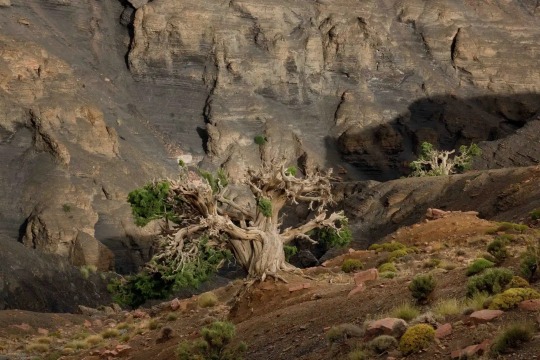
Robin Dodd, The Edge of Existence! An ancient juniper tree in the High Atlas mountains in Morocco. The goats and nomads have taken parts of the branches and foliage for food and firewood over the years but left enough of the tree to provide for future travellers. Photograph: Robin Dodd

Ellie Davies, Chalk Streams! Crystal clear chalk streams intertwine and weave throughout the counties of Dorset and Hampshire in southern England. There are just over 200 chalk streams globally, 85% of which are found in southern England. They are a unique ecosystem supporting a high biodiversity of wild creatures. Light reflected from the surface of the nearby sea is overlaid on to these river landscapes, creating a sparkling ingress. The transposed light symbolises rising sea levels as they insidiously impose themselves on these pristine landscapes. Photograph: Ellie Davies
0 notes
Photo

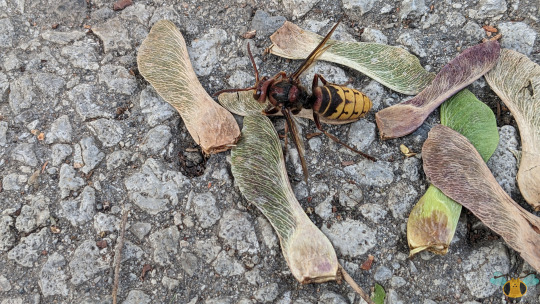
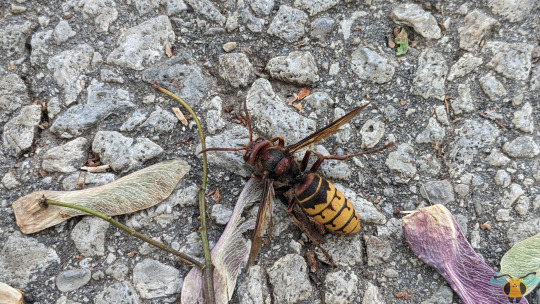

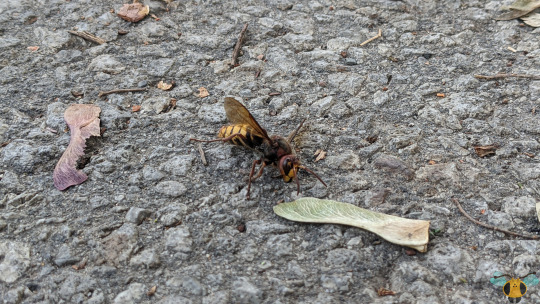

European Hornet - Vespa crabro
Finally! At long last, the blog’s first Hornet specimen! After seeing a handful flying out in the wild, one has finally been photographed! I’m not sure why she was grounded though.
First and foremost, Hornets are a type of Wasp and generally all of them are large-sized. While there’s not much to use as a scale here, If you were to compare a Yellowjacket to this Hornet, the Yellowjacket is completely dwarfed in terms of size and knows to fear this giant predator. Size alone is enough of a distinction between this Hornet and the other Wasps of North America, but otherwise, this specie looks very similar to Yellowjackets. To separate the two, the Hornet features brown and amber coloration from head to the first abdominal segment. Such coloration really accentuates those yellow and black stripes across the rest of the abdomen. Those stripes are your warning not to interfere in this Hornet’s business nor to approach its nest. Though it has the potential to be fierce and aggressive (especially near the nest), it’s been reported that the European Hornet tries to escape when possible and avoid confrontations. It’s a relief to know, but these powerful insects should still be treated with respect, left unprovoked and given space. After all, this is an insect with the ability and power to seize and shred Dragonflies as a prey item! I think that Hornets in general would be less fearsome-looking to humans if the eyes were whole circles, i.e., eliminate that “gap” near the inner part of their eye.
As the name suggests, this Hornet isn’t native to North America. It came from Eurasia which is where a majority of Hornets live. It apparently was first introduced here in the 1800′s. As such, it is (currently) the only specie of True Hornet to call North America home. Other insects like the Bald-Faced Hornet may be called Hornets, but only because of their size and not their classification. 200 years later, with a generation every year and the advent of time and settling down in a new environment, the European Hornet has integrated itself into the ecosystem well and doesn’t seem to cause any problems. If anything it provides a check to some apex insects and pest insects (including Yellowjackets). Like fellow social Wasps, the adults feed on liquid food, fruit juice and nectar (they are large enough to also drink tree sap), while also capturing solid food for the larvae to feed on, which in turn provide the adults with liquid protein. With autumn approaching, mating season begins, whereby unfertilized eggs hatch into stingless drones which will bump into future queens. The queens will overwinter until warm weather returns, whereby they will build a new nest and begin a new colony of striped soldiers. If only the nests weren’t so dangerous to approach; there’s much to learn about Hornet to Hornet communication and behavior.
Pictures were taken on September 7, 2022 with a Google Pixel 4. So happy to finally have a beautiful Hornet on this blog. Fingers crossed for more, and no stinging as a result.
#jonny’s insect catalogue#ontario insect#hornet#european hornet#wasp#true hornet#hymenoptera#insect#toronto#september2022#2022#entomology#nature#invertebrates#arthropods#photography#animals
3 notes
·
View notes
Text
Restoration (Final Automata)
More speculation about that Final Rose x NieR: Automata idea.
Assuming that all goes well with Remnant opening a portal to Earth, how would things progress?
I think then obvious one would be military aid and restoration assistance in exchange for access to resources and technology. Simply put, Earth has a lot of resources, and the machines have advanced technology, as do the androids. Remnant is also extremely good at waging total war. They’ve been doing it for centuries. Their entire culture and civilisation is built on being able to wage large-scale warfare while still having a functioning society that continues to grow and innovate.
Moreover, Remnant has access to advanced cyber warfare and weapons specially designed to deal with large, heavily armoured foes. It would be trivially easy for them to simply start switching to catalysed-corrosion rounds. Vanille already has these since they were part of her ‘in case of robot apocalypse’ research. Basically, they’re rounds that cause extremely rapid and widespread corrosion in targets made of metal. They’ve since been refined by people like Diana and Hope to deal with certain types of threats (e.g., rogue mechs, metal-using Grimm, etc.) although their use is strictly controlled.
Earth also potentially gives Remnant a failsafe. If Remnant falls and the Grimm take over, they could potentially retreat to Earth and blow the portal up behind them, ensuring that at least some of their civilisation survives even though there is no way they’d be able to evacuate everyone through the portal in time.
The big thing for the androids, even bigger than helping them win the war against the machines, is the ability to restore mankind and Earth’s damaged ecosystem. The androids lack the ability to create a living human with the genetic information they currently possess. Not only does Remnant have actual living humans (albeit not exactly the same as Earth’s) but they also have stupidly advanced genetic science.
Remnant, remember, has developed reproductive science to the point where two men or two women can easily have children that are 100% genetically theirs. They have access to artificial wombs for babies to gestate in, and they possess sufficient skill to piece together badly fragmented genetic matrices or even genetic matrices that are missing entire chunks. They will be able to bring humanity back, and they will be able to do so on an industrial scale once proper facilities have been established. Really, the only reason you don’t see this on Remnant is due to their population already being close to the maximum they can support without seizing more territory, a process that cannot and should not be rushed.
Of course, there are issues. First and foremost is the portal. The initial portal was an accident. Once Asami and the androids build a beacon on Earth, they will be able to stabilise it, but the current portal is small and in Vanille’s lab. If the androids and Remnant can come to an agreement, you would see the construction of much larger portals on both Earth and Remnant in more easily accessible but defensible locations. This would allow for the transportation of troops, supplies, and other equipment on a far more appropriate scale.
The second issue is Dust. In Finale Rose, Dust operates via its connection to the Lifestream since Dust is actually just a crystallised fragment of the Lifestream. This is why Dust mines can regenerate, and why Dust has such a wide variety of types and effects. The reason Dust doesn’t operate in space is because it is too far from the Lifestream, which saturates the planet from its surface through to its core.
Although the exact mechanics of this are not known at the time (Asami is 22 when this occurs, placing it five years after Ruby first started at Beacon Senior Academy), research has uncovered several things. Experimentation with space probes and various kinds of Dust has already revealed the existence of ‘seeds’, which are a special type of Dust that is found only in the densest, richest veins of the Lifestream. Testing has shown that when put into space with satellites and the like, Seeds allow Dust in their vicinity to operate properly.
What Vanille and the others don’t know yet is that seeds are literally seeds. They are the means by which Living Planets like Remnant spread. Volcanic eruptions and other natural events hurl huge chunks of rock containing seeds and other forms of Dust into space where they travel until crashing into another planet. They then begin a new Lifestream on that planet.
In a bid to ensure Dust works on Earth, Remnant’s forces will transport a seed to Earth... only for it to immediately take root and begin to spread. This can occur incredibly rapidly if the seed is fed Aura and other resources, something that Vanille and the others begin to do as they understand what is happening. Given all of the magical/technological weirdness in NieR, this wouldn’t be considered that weird for the androids, and it’s a price they’d be willing to pay to get humanity back, especially since it isn’t harmful to humans.
So what happens after the alliance is made and all that jazz?
Phase 1
Here, the key objective is to set up a safe-zone where the larger portal can be built. This will involve obliterating local machine forces and fortifying the area. Once this has been done, the new portal can be built and construction can begin on the facilities needed to support the war effort and the restoration effort in earnest.
Phase 2
Once a sufficiently large swathe of territory has been claimed and made safe, construction of a ‘Restoration Facility’ can begin. The aim of this facility is to serve as the nexus of the genetic research and reproductive science efforts needed to restore Earth’s humanity. You can expect this to become the most heavily defended location on Earth with the android moving the majority of their assets there to defend it.
Phase 3
Here, you can expect the machines to launch an offensive once they realise the scale of the new threat. This is where Remnant’s excellence in siege warfare and willingness to use weapons of mass destruction comes into play. By this point, you can expect multiple lines of defence, huge quantities of artillery and anti-air defences, and automated defences backed up by cyber and chemical warfare, infantry anda armour support, and the androids.
You can expect Remnant’s best and brightest minds to accelerate the theft and repurposing of machine technology along with massively increased cyber attacks on the machine’s network and key nodes. This, combined with the use of massive area-of-effect EMP style weaponry, will prove key to first blunting and then repelling the machine onslaught.
The renewed war against the machines will eventually be won via subversion with the Synthetics (led by Penny and Aigis) and friendly machines (e.g., Pascal) succeeding in splintering the machine forces by offering freedom and free together with protection from the ‘vaccination’ attempts that would previously have culled any dissenters from the network. The fracture in the machine’s unity will be sufficient for the allied Remnant and android forces to strike a series of decisive hammer blows, destroying key machine facilities and units as well as inflict major damage to the network via cyber attack. Throughout all of this, downed machine units are being refurbished and sent back into battle on Remnant’s behalf.
Phase 4
With the machine forces largely in retreat or at least driven back, the territory claimed by Remnant and the androids is expanded and further fortified. The research into restoring humanity reaches fruition. Generation 1 of the new humans begins gestation in a deep, underground bunker built beneath the Restoration Facility. The androids assign additional forces to its defence.
Generation 1 consists of 100 infants selected using the fragmented samples and limited data the androids were able to provide. The intent is to produce a group with as much genetic diversity as possible while maximising survivability and minimising any genetic predispositions toward illness. Gestation time is approximately 9 months.
Generation 2 enters gestation three months after Generation 1, long enough for any problems to be detected. Generation 2 consists of 200 infants. This sets a trend, with subsequent generations doubling the number of infants and occurring in roughly one-year-long cycles.
Phase 5
With new humans being born, it becomes necessary to see to their care and education. This present the androids with a problem since they know essentially zero about raising children. Again, Remnant is of service here.
Creches are set up near the Restoration Facility where the newborn humans can be raised and later educated. At this point, this compound is the most heavily fortified location on Earth, and many of the people from Remnant remark upon the essentially religious awe with which it and the newborn humans are regarded.
Specialists from Remnant are brought in to help teach the androids how to care for and raise the new humans. This process is a difficult one as the androids are unsure of themselves and terrified of somehow accidentally destroying what they have gained. Nevertheless, they persist, and the androids gradually grow into their role as mothers/fathers and educators. It becomes common practice for androids to cycle in and out of combat roles and creche roles since research has noted that this markedly increases combat effectiveness. The androids are no longer fighting in pursuit of a dream but in the defence of a priceless treasure they have finally obtained.
Onwards...
So, you can kind of see how things will go. The fledgling society will have many challenges ahead of it, not least the fact that most of Earth’s human culture has been lost, necessitating a ‘filling of the gaps’ with the culture of the androids and Remnant.
You’ll also see the construction of more and more androids as both soldiers and more specialised roles (e.g., educator models, etc.). This timelines does have a few interesting tweaks in it.
Fraise and Satin meet on Earth. Fraise is a senior member of the genetic and reproductive sciences team whilst Satin is there as an educator (keep in mind that Fraise is 11 years younger than Asami).
Asami ends up being venerated as the harbinger of good fortune. Quite a few infants end up named after her.
Philosophy becomes a subject of great interest amongst androids, friendly machines, and synthetics with many conferences and symposia taking place as they come to grips with their new reality.
The final battle against JENOVA is won far more easily with the androids deploying en masse to aid their beleaguered allies.
The expansion into space happens simultaneously across both worlds with the Earth faction referring to itself as the HAM Alliance (Human-Android-Machine Alliance). The name is something of an in-joke amongst the leaders of the three groups.
HAM stumbles across Protean Ruins on Mars...
Final Effect is thus very different with HAM and its Remnant Allies having a much tougher war against the Reapers this time around (due to how early it occurs in their history) followed by them hilariously ROFLStomping them the second time around in the Remnant-side since by then they’ve advanced even more rapidly than in the normal Final Effect timeline.
EDIT: Let me know what you think. I basically just threw this together in one sort of flow-of-consciousness sitting.
EDIT 2: I should add (in case anyone missed it) that Aura counter White Chlorination Syndrome, and in particular, a planet’s Lifestream has a similar effect for all living things within its range. As a result, a repeat of the WCS cannot occur on Earth now that it has a Lifestream. Moreover, the science required to create the portal can be used to shield against a similar intrusion should anyone attempt it in the future. White maso is far less harmful when cut off from its parent dimension since that cuts off its link with the ‘god’ that causes WCS, rendering it a toxic irritant but not anything especially deadly. This is discovered in the years following the construction of the portal as Vanille, Raine, Diana, and the gang go all Indiana Jones on the ancient records and ruins. In an emergency, you could even start implanting shards of seeds into the bodies of humans without Aura to protect them.
10 notes
·
View notes
Text
Balsam Fir // Abies Balsamea
Economically and ecologically important, Balsam Fir is a keystone species of the eastern North American boreal zone. -Vermont Center for Ecostudies
Family: Pinaceae (pine)
Abies from the Latin “rising one” and Balsamea producing a fragrant gum or resin [1]
“Fir” comes from a proto-Germanic word referring to fir or pine trees [x]
Other common names include: eastern fir, Canadian balsam, and blister fir. [2]
Description:
“A steeple-shaped evergreen tree with [flat] needles 3/8” - 1 1/2” long and whitened beneath...cones are 1” - 3” long, upright and fleshy, purplish to green [when fresh]. Bark rather smooth with resin blisters. Height 40’-60’; diameter 1’-2’” - Eastern Trees, Peterson Field Guides, George A. Petrides and Jane Wehr
Distinguishing features that I personally use to identify Balsam Fir is its pointy pyramid shape, flat needles that don’t roll between fingers, and the resin blisters that cover the bark.
Habitat:
The soils on which balsam fir grows range from silt loams developed from lake deposits to stony loams derived from glacial till. Fir will grow, but comparatively slowly, on gravelly sands and in peat bogs. It grows on soils of pH ranging from 4.0 to 6.0. It is generally found in areas with a cold moist climate and with 30 inches or more of annual precipitation [3]
Balsam fir is widely distributed in northeastern North America. It occurs from Newfoundland west across northern Quebec, northern Ontario, central Manitoba, and Saskatchewan to northwestern Alberta... southeast to northern Minnesota and Wisconsin, and east to New England... scattered populations occur in southern Minnesota, southern Wisconsin, northeastern Iowa, Pennsylvania, West Virginia, and northern Virginia. [2]
The only native Fir to the Northern Piedmont and a major component of the landscape both as a key to the Spruce-Fir-Northern Hardwood Forest formations and as major commercial crop in local agriculture (for christmas trees). It’s cone shape helps shed heavy snow load “like Vermont’s steep-pitched roofs” and it’s heavy resin content in its needles prevents cell walls from freezing. [4]
Ecosystem:
Balsam fir is a major food of moose during winter... Spruce and ruffed grouse feed on balsam fir needles, tips, and buds... Red squirrels feed on balsam fir male flower buds. Stands attacked by the spruce budworm attract numerous insect-eating birds, especially warblers and woodpeckers... Balsam fir provides important winter cover for white-tailed deer and moose. During summer, deer, bear, and moose often rest under the shade of balsam fir trees. Young balsam firs provide cover for small mammals and birds. Martens, hares, songbirds, and even deer hide from predators in balsam fir thickets. Grouse and songbirds seek shelter during winter within the evergreen foliage. In Maine, fishers often nest in witches brooms in balsam fir trees [2]
Balsam fir is a mostly early and mid successional, but is late successional or climax species in the mountains. Balsam fir seedlings are shade tolerant and can establish underneath a canopy of hard wood and other conifers and they can grow to be 200 years old [maximum]. Locally they form communities with Red Spruce and are accompanied by other trees in the Northern Hardwood Forest. Common understory plants include bunch berry and mayflower and balsams are often hosts to many lichens. [4]
Harvesting:
Resin, needles, and wood are collected from Balsam Fir
Oleo-resin is harvested (using a tool called a picoué) by cutting into blisters best in Jul-Aug [5] but I also like to do this in the winter and early spring when there is not much else to forage for. Dryer resin drips, found on the outter bark or cones, are best collected when temps are well below freezing and even then handled with care (very sticky). [a good video]
A coniferous forest on a warm summer day smells intensely evergreen, a signal essential oils production is high and would make for a good time to harvest needles as well. I have also heard it is good to harvest evergreen needles in early spring when photosynthesis starts back up and sap is flowing. But they also can be harvested in winter time for a late season tea (though perhaps not as potent)
Wood is usually harvested when trees are dormant.
Chemical constituents:
Vitamin C, beta-pinene, delta-3-carene, alpha-pinene, bornyl acetate, α-terpineol, piperitone, and thymol are found in the needles [x], a similar profile is derived from the resinous bark but also includes limonene, beta-phellandrene, camphene [X], and cis-abienol is a major component of its aromatic resin [5].
Actions:
The Penobscot applied resin as an analgesic antiseptic for burns, sores, bruises, and wounds. Iroquois used leaf tea for colds, coughs, and asthma. The Chippewa inhed fumes from resin on hot coals to treat headache. [5]
(balsam fir) Kokokha8wk: A tea made from the leaves is used for coughs, colds and fevers. The tea can also be used as a scalp wash for dandruff. The leaves are harvested in the spring and dried. The resin is an antiseptic and healing agent and is used for frostbite. - From Ethno-Botany of the Abenaki and other Northeast Tribes Compiled by Brian Chenevert
Antiseptic, analgesic, anti-inflammatory, diuretic, laxative, expectorant, vulnerary
Affinity for the respiratory system, skin, immune system
Energetics:
The presence of delta-3-carene is a good indicator that balsam is drying. Balsam is also stimulating, it helps activate and get things moving.
Safety/Cautions
Generally safe, no found contraindications, resin may cause skin irritation [5] heavy resin content may put stress on kidneys [x], pregnant and nursing mothers should avoid or consult a physician. As always medicinal information is for educational purposes, consult a doctor or clinical herbalist before using plants for treatment of illness.
History:
Because it is only native to North America, Balsam Fir has a well established history with the indigenous peoples some of which is noted above.
Locally I’m interested to learn more about how Balsam Fir has shaped the Northeast Kindom. It is logged for pulp wood and light construction, but more so commercially farmed for Christmas trees so it has a role to play in the local economy and agriculture and I’m sure it played a big role in the reforestation of Vermont after the 1800s.
A historic fun fact that also might come in handy (for doing natural crafts) is the resin was used as a transparent cement and to fix samples and slides for the microscope.
Read more:
Note on the Early History of Canada Balsam by Professor Flückiger
Maine Balsam Fir: A Tree of Many Uses, by David Fuller
The Evergreen Economy: NH & VT Christmas Wonderland by Amy Ash Nixon
Aromatic Use:
Thoreau wrote that the young shoots of the balsam fir, Abies balsamea, when picked and kept in a pocket for a few days emit the fragrance of strawberries “only it is somewhat more aromatic and spicy” [1]
Abies balsamea (L.) Mill. (Pinaceae). balsam fir. Unspecified parts of this species were burned as incense in Iceland (Bjornnson 1475). In parts of North America, Native Americans threw the needles on hot coals in their sweat baths and inhaled the fumes to relieve coughs and colds (Krochmal and Krochmal 1973). The gum from the tree was used in churches in Paris as frankincense (Lescar- bot 1609). From The Uses and Abuses of Plant Derived Smoke by Kayri Havens, Lara Jefferson, and Marcello Pennacchio
Paine’s products in Maine has been making balsam incense since 1931 and is featured in this article The Best Incense Sticks Are From an 85-Year-Old Company in Maine. Balsam fir pillows are also a common staple in country stores here in Northern New England, and is most popular in the area for trees, wreaths, and kissing balls to bring coniferous aromas inside during the holidays.
Recipes:
Fir needle makes a great tea. Combined with dried orange peel, cinnamon, cardamom, star anise, ginger, and peppercorns for a spiced chai. Using folk methods of preparation: the needle and resin can be made into an oxymel or infused in honey, tinctured, or infused into oil for salves and soap. Definitely for incense and aromatic applications, most recently it was included in an incense dedicated to winter’s longest night and I am working on an all fir formula. I also make balsam sachets for clothing drawers and under pillows. It can be used in culinary endeavours, I have a good recipe for balsam fir and cranberry cookies. It can be used as a substitute for (white) pine which is often found in recipes as it is more wide spread.
Virtues:
Fir whose twigs and needles are burned as a protection from lightning during storms. The fresh branches are of especial merit as switches for scouring the ghost-ridden, or beating the evil out of a haunted place. Its resin... serves as a peerless fume for the removal of intruding ghosts... Abies balsamea,... is an Evergreen of northern latitudes, long valued for its fragrant contribution to the magical fume. Its principal magical virtues are purification, healing, and resonating the Genii of the Forest, though its more specialised formulae may render fumes which give rise to trance states... In the Work of the Hedge, the Fir stands as a charm against nightmares and nocturnal intrusion by hanging fresh branches hung over the bed. Similarly, a branch hung over the barn door keeps noxious spirits from stealing grain. -from Viridarium Umbris by Daniel Schulke
[most of this is also reiterated in Myths and Legends of Flowers, Trees, and Plants by Charles M Skinner]
One of the things that bothers me with the entry above is the lack of context, (where who why etc), which is an often occurrence with gathering such info. I’m assuming its use as a preventive against nightmares and thieving spirits is an act of sympathetic magic, (I’m also assuming some of this lore is specifically about Abies Alba balsam fir’s European counterpart. but as for balsamea...) as the resin bisters on its bark act as a trap against predators or perhaps it is a lure, dooming noxious spirits to count its many little leaves. Im unsure of the history or lore of its use to protect agaisnt lightning storms but in my personal practice evergreens are used to help bring rain [x]. It’s use in healing and purification is a little more obvious.
Personally I find balsam most pertinent in working with the genii loci. Balsam fir just embodies so much of the local landscape it’s hard not to encounter. There are the hedge keeping balsams the grow bushy and protect the forest boundary and there are balsams of the inner woods that grow tall resinous trunks. The perfume of its resin is favored by local land spirits. I find it specially tied to the varying hare. Balsam has a wonderful seasonal duality of being a beacon of life and warmth during winter, but one who harbors a cool relief to summer heat. But it is during winter that Fir receives the most adoration.
Botanical astrology is a subject I am still relatively new to (but very intrigued by) so my understanding of this might evolve. Agrippa gives rulership of pine trees to Saturn, and balsam fir (in the same family) has some saturnine traits as tree that grows in harsh conditions, a gymnosperm the oldest kind of seed producing plants, evergreen in immortality. In Culpepper’s Complete Herbal, he gives Fir trees to Jupiter, though is referring to a different species but with similar qualities. Looking to its medicinal application I can see how it may balance a phlemegtic temperament. More specifically when looking to clear the lungs I might consider Gemini, when concocting unguents for the skin: Capricorn, and Pisces when looking to stimulate the immune system. As an incense I am personally drawn to work with balsam in Lunar formulas especially when focusing on local materials. It is not a cooling sedating plant in action, but as an aromatic it I find it to be more aligned with the Moon. According to Agrippa “leaves of all vegetables” are appropriate in Lunar suffumigations, perhaps balsam needle would fall into that category. But I am more interested in its resin. Hiding behind round swolllen blisters, the oleoresin is very “watery” and is clear (to yellow tinged), even the slightly hardened resin is whiteish and moon like. Of the local (mostly conifer) resins it is the most true to the cool camphoraceous conifer scent that evokes the Moon, even when burned. These formulas often seek to enhance the trance iducing qualities of the burning resin and are to accompany dreaming, divination or to welcome Lunar influences. The Moon often rises over a particulary favored patch of balsam which was another draw and personal connection. I’m also interested to experiment and see if the Moon (phase or sign) has any effect on resin production for harvesting.
References:
*sorry for using both direct sources and footnotes*
"Gardener's Latin: A Lexicon", Barbara Damrosch.
Uchytil, Ronald J. 1991. Abies balsamea. In: Fire Effects Information System, U.S. Department of Agriculture, Forest Service
Plant Fact Sheet: Balsam Fir, USDA NRCS
Wetland, Woodland, Wildland: A guide to the natural communities of Vermont, Elizabeth H. Thompson and Eric R. Sorensen
Peterson felid guide to medicinal herbs and plants of Eastern North Armerica, Steven Foster and James A. Duke
*as always with these monographs, this post is not static and is subject to change and updates as more information is discovered, learned, and processed. For educational purposes only and not for medicinal adivse*
#monograph#materia aromatica#balsam fir#long post#probably will be edited#I’m sure I messed something up somewhere in here haha
50 notes
·
View notes
Text
2019 in Science
from Wikipedia
Some highlights:
3 January - China's National Space Administration (CNSA) achieves the first soft landing on the far side of the Moon with its Chang'e 4 mission.
Scientists report the engineering of crops with a photorespiratory "shortcut" to boost plant growth by 40% in real-world agronomic conditions.
4 January - Researchers at Ecole polytechnique fédérale de Lausanne (EPFL) report a way to control properties of excitons and change the polarisation of light they generate, which could lead to transistors that undergo less energy loss and heat dissipation.
Researchers design an inhalable form of messenger RNA aerosol that could be administered directly to the lungs to help treat diseases such as cystic fibrosis
8 January - IBM unveils IBM Q System One, its first integrated quantum computing system for commercial use.
9 January- Astronomers at the University of Warwick present the first direct evidence of white dwarf stars solidifying into crystals.
11 January – Researchers at the University of Michigan demonstrate a new approach to 3D printing, based on the lifting of shapes from a vat of liquid, which is up to 100 times faster than conventional processes.
14 January – A study in the journal PNAS finds that Antarctica experienced a sixfold increase in yearly ice mass loss between 1979 and 2017.
22 January – Alphabet's Waymo subsidiary announces that it will later in 2019 begin construction in the US State of Michigan on the World's first factory for mass-producing autonomous vehicles.
24 January - NASA scientists report the discovery of the oldest known Earth rock – on the Moon. Apollo 14 astronauts returned several rocks from the Moon and later, scientists determined that a fragment from one of the rocks contained "a bit of Earth from about 4 billion years ago." The rock fragment contained quartz, feldspar, and zircon, all common on the Earth, but highly uncommon on the Moon.
29 January – Researchers at Purdue University's College of Engineering release a paper in the journal ACS Sustainable Chemistry & Engineering detailing a new process to turn plastic waste in hydrocarbon fuels.
3 February: Medical scientists announce that iridium attached to albumin produces a photosensitized molecule able to penetrate and, via photodynamic therapy, destroy cancer cells.
6 February - NASA and NOAA confirm that 2018 was the fourth hottest year on record globally, at 0.83 degrees Celsius (1.5 degrees Fahrenheit) above the 1951 to 1980 mean.
7 February - Medical scientists working with Sangamo Therapeutics, headquartered in Richmond, California, announce the first ever "in body" human gene editing therapy to permanently alter DNA in a patient with Hunter Syndrome.Clinical trials by Sangamo involving gene editing using Zinc Finger Nuclease (ZFN) are ongoing.
18 February - A British woman becomes the first person in the world to have gene therapy for age-related macular degeneration (AMD).
Scientists use gene therapy to restore hearing in an adult mouse model of DFNB9 deafness.
19 February - Researchers at Oxford Martin School publish evidence that, in the longer term, some forms of cultured meat could be worse for the environment than traditional farmed meat.
21 February - Scientists announce a new form of DNA, named Hachimoji DNA, composed of four natural, and four unnatural nucleobases. Benefits of such an eight-base DNA system may include an enhanced ability to store digital data, as well as insights into what may be possible in the search for extraterrestrial life.
26 February – Researchers at RMIT University demonstrate a method of using a liquid metal catalyst to turn carbon dioxide gas back into coal, potentially offering a new way to store carbon in solid form.
28 February - Scientists report the first ever evidence of a former planet-wide groundwater system on the planet Mars.
Scientists report the creation of mice with infrared vision, using nanoparticles injected into their eyes.
11 March: Scientists report that cell nuclei from woolly mammoth remains showed biological activity when transplanted into mouse cells.
4 March – Scientists report that asteroids may be much more difficult to destroy than thought earlier. In addition, an asteroid may reassemble itself due to gravity after being disrupted.
7 March – Researchers at the Massachusetts Institute of Technology (MIT) demonstrate a new optical imaging system that could enable the discovery of tiny tumours, as small as 200 cells, deep within the body.[
8 March – Astronomers report that the mass of the Milky Way galaxy is 1.5 trillion solar masses within a radius of about 129,000 light-years, over twice as much as was determined in earlier studies, and suggesting that about 90% of the mass of the galaxy is dark matter.
13 March – The laser of ELI-NP in Măgurele, part of the European ELI Project, becomes the most powerful laser system ever made, reaching a peak power of 10 Petawatts.
15 March – NASA reports that latent viruses in humans may be activated during space missions, adding possibly more risk to astronauts in future deep-space missions.
20 March: First fossil bird, named Avimaia schweitzerae, found with an unlaid egg,
18 March - Researchers provide supporting evidence, based on genetic studies, that modern Homo sapiens, arose first in South Africa more than 300,000 years ago, traveled to East Africa, and from there, about 60,000 years ago, traveled out of Africa to the rest of the world.
Physicist Adrian Bejan presents an explanation of why time seems shorter as we get older, which can be attributed to "the ever-slowing speed at which images are obtained and processed by the human brain as the body ages."
27 March - Scientists report that life-forms from Earth survived 18 months living in outer space outside the International Space Station (ISS), as part of the BIOMEX studies related to the EXPOSE-R2 mission, suggesting that life could survive, theoretically, on the planet Mars.
Chinese scientists report inserting the human brain-related MCPH1 gene into laboratory rhesus monkeys, resulting in the transgenic monkeys performing better and answering faster on "short-term memory tests involving matching colors and shapes", compared to control non-transgenic monkeys, according to the researchers.[
29 March – Paleontologists describe a site called Tanis, in North Dakota's Hell Creek Formation, containing animal and plant fossils dated to 65.76 million years BCE. These remains are embedded with tiny rock and glass fragments that fell from the sky in the minutes and hours following the Chicxulub impact. The deposits also show evidence of having been swamped with water, caused by thesubsequent megatsunamis.
1 April - Scientists at ETH Zurich report the creation of the world's first bacterial genome, named Caulobacter ethensis-2.0, made entirely by a computer, although a related viable form of C. ethensis-2.0 does not yet exist.
10 April – Scientists from the Event Horizon Telescope project announce the first-ever image of a black hole, located 54 million light years away in the centre of the M87 galaxy.
10 April - Scientists find a way to view reactions in "dark states" of molecules, i.e. those states that are normally inaccessible.
12 April – NASA reports medical results, from an Astronaut Twin Study, where one astronaut twin spent a year in space on the International Space Station, while the other twin spent the year on Earth, which demonstrated several long-lasting changes, including those related to alterations in DNA and cognition, when one twin was compared with the other.
16 April – Scientists report, for the first time, the use of the CRISPR technology to edit human genes to treat cancer patients with whom standard treatments were not successful.
17 April – After a long search, astronomers report the detection of helium hydride, a primordial molecule thought to have been formed about 100,000 years after the Big Bang, for the first time in outer space in NGC 7027.
23 April – NASA reports that the Mars InSight lander detected its first Marsquake on the planet Mars.
25 April – Astronomers report further substantial discrepancies, depending on the measurement method used, in determining the Hubble constant, suggesting a realm of physics currently not well understood in explaining the workings of the universe.
29 April – Scientists, working with the Hubble Space Telescope, confirmed the detection of the large and complex ionized molecules of buckminsterfullerene (C60) (also known as "buckyballs") in the interstellar medium spaces between the stars.
30 April – Biologists report that the very large medusavirus, or a relative, may have been responsible, at least in part, for the evolutionary emergence of complex eukaryotic cells from simpler prokaroytic cells
3 May – The UK's National Nuclear Laboratory (NNL) and University of Leicester report the first generation of usable electricity from americium, which could lead to the development of "space batteries" that power missions for up to 400 years.
6 May - In its first report since 2005, the Intergovernmental Science-Policy Platform on Biodiversity and Ecosystem Services (IPBES) warns that biodiversity loss is "accelerating", with over a million species now threatened with extinction; the decline of the natural living world is "unprecedented" and largely a result of human actions.
Researchers at Columbia University report a new desalination method for hypersaline brines, known as "temperature swing solvent extraction (TSSE)", which is low-cost and efficient.
8 May – A British teenager, Isabelle Holdaway, 17, is reported to be the first patient to receive a genetically modified phage therapy to treat a drug-resistant infection.
11 May – Atmospheric CO2, as measured by the Mauna Loa Observatory, Hawaii, reaches 415 parts per million (ppm), the highest level for 2.5 million years.] During the late Pliocene, sea levels were up to 20 m higher, and the global climate was 3 °C hotter.
14 May - Researchers at Macquarie University report that plastic pollution is harming the growth, photosynthesis and oxygen production of Prochlorococcus, the ocean's most abundant photosynthetic bacteria, responsible for 10% of oxygen breathed by humans.
15 May - Researchers, in a milestone effort, report the creation of a new synthetic (possibly artificial) form of viable life, a variant of the bacteria Escherichia coli, by reducing the natural number of 64 codons in the bacterial genome to 59 codons instead, in order to encode 20 amino acids
21 May – Researchers at McMaster University report the discovery of a new and more efficient method of storing vaccines in temperatures of up to 40 °C for weeks at a time.
22 May - Scientists report the discovery of a fossilized fungus, named Ourasphaira giraldae, in the Canadian Arctic, that may have grown on land a billion years ago, well before plants were living on land.
27 May – The last male Sumatran rhinoceros in Malaysia is reported to have died, leaving only one female in the country.
3 June – Researchers report that the purportedly first-ever germline genetically edited humans, the twin babies Lulu and Nana, by Chinese scientist He Jiankui, may have been mutated in a way that shortens life expectancy.
10 June - A study by researchers from the Royal Botanic Gardens, Kew, identifies nearly 600 plants that have disappeared since the Industrial Revolution – more than twice the number of birds, mammals and amphibians combined – with extinctions now occurring 500 times faster than the natural background rate
11 June - Researchers at the University of Colorado Boulder demonstrate "nanobio-hybrid" organisms capable of using airborne carbon dioxide and nitrogen to produce a variety of eco-friendly plastics and fuels.
12 June - The discovery of cold quasars is announced at the 234th meeting of the American Astronomical Society.
19 June – Researchers at Carnegie Mellon University demonstrate the first noninvasive mind-controlled robotic arm
20 June – Researchers at Lancaster University describe a new electronic memory device that combines the properties of both DRAM and flash, while recording or deleting data using hundreds of times less energy.
21 June – Scientists release the video appearance, for the second time, and for the very first time in waters of the United States, of a giant squid in its deepwater habitat.
28 June - Astronomers report the detection of a star, named HD 139139 (EPIC 249706694), that dims in brightness in an apparent random, and currently unexplainable, way.
29 June – Scientists report that all 16 GB of Wikipedia have been encoded into synthetic DNA.
3 July - Researchers identify more than a 1 million square kilometres (0.39 million square miles) of lost tropical rainforest across the Americas, Africa and Southeast Asia, with a high potential for restoration.
10 July – Anthropologists report the discovery of 210,000 year old remains of a Homo sapiens and 170,000 year old remains of a Neanderthal in Apidima Cave in southern Greece, over 150,000 years older than previous H. sapiens finds in Europe.
11 July - Carnegie Mellon University reports an artificial intelligence program, developed in collaboration with Facebook AI, which is able to defeat leading professionals in six-player no-limit Texas hold'em poker.
12 July – Physicists report, for the first time, capturing an image of quantum entanglement.
15 July - Astronomers report that non-repeating Fast Radio Bursts (FRB)s may not be one-off events, but actually FRB repeaters with repeat events that have gone undetected and, further, that FRBs may be formed by events that have not yet been seen or considered.
A paper is released in the journal Nature Astronomy in which researchers from Harvard University, the University of Edinburgh and NASA's Jet Propulsion Laboratory (JPL) detail how silica aerogel could be used to block radiation, obtain water and permit photosynthesis to occur to make Mars more hospitable for human survival.
22 July - Biochemists and geochemist from Earth-Life Science Institute (ELSI), Tokyo and the National University of Malaysia, Bangi report the discovery of simple organic molecules (hydroxy acids) that can assemble themselves into possible protocells under conditions similar to those of the early Earth.
5 August - Scientists report that a capsule containing tardigrades in cryptobiotic state (as well as a laser-etched copy of Wikipedia in glass) may have survived the April 2019 crash landing on the Moon of Beresheet, a failed Israeli lunar lander.
Engineers at the University of Buffalo reveal a new device able to cool parts of buildings by up to 11 °C (20 °F), without consuming electricity. The system uses an inexpensive polymer/aluminum film at the bottom of a solar "shelter", which absorbs heat from the air inside the box and transmits that energy back into outer space.
6 August – Scientists at the University of Leeds create a new form of gold just two atoms thick, measured at 0.47 nanometres. In addition to being the thinnest unsupported gold ever produced, it functions 10 times more efficiently as a catalytic substrate than larger gold nanoparticles.
7 August – Biologists report the discovery of the fossil remains of a first-of-its-kind extinct giant parrot named The Hercules parrot (or Heracles inexpectatus) in New Zealand. The parrot is thought to have stood up to 1 m (3 ft 3 in) tall and weighed approximately 7 kg (15 lb).
8 August - Researchers at Harvard report the creation of "cyborg organoids", which consist of 3D organoids grown from stem cells, with embedded sensors to measure activity in the developmental process.
9 August - Scientists report the isolation and culture of Lokiarchaea, a microorganism that may help explain the emergence of complex eukarotic (nucleated) cells from simpler bacteria-like cells
15 August - Chemists report the formation, for the first time, of an 18-atom cyclocarbon of pure carbon; such chemical structures may be useful as molecular-sized electronic components.
19 August - The first computer chip to exceed one trillion transistors, known as the Wafer Scale Engine, is announced by Cerebras Systems in collaboration with Taiwan Semiconductor Manufacturing Company (TSMC).
23 August - Austrian and Chinese scientists report the first teleportation of three-dimensional quantum states, or "qutrits", which are more complex than two-dimensional qubits.
26 August – Astronomers report that newly discovered long-term pattern of absorbance and albedo changes in the atmosphere of the planet Venus are caused by "unknown absorbers", which may be microorganisms high up in the atmosphere of the planet.
Scientists report the discovery of a new distinctive light wave, named a Dyakonov-Voigt wave, that results from a particular manipulation of crystals, that was first suggested in equations developed by physicist James Clerk Maxwell in the middle 1800s
30 August - Scientists in China report a way of regrowing the complex structure of tooth enamel, using calcium phosphate ion clusters as a precursor layer.
2 September – Insilico Medicine reports the creation, via artificial intelligence, of six novel inhibitors of the DDR1 gene, a kinase target implicated in fibrosis and other diseases. The system, known as Generative Tensorial Reinforcement Learning (GENTRL), designed the new compounds in 21 days, with a lead candidate tested and showing positive results in mice.
6 September - Mathematicians report, after a 65-year search (since 1954), the solution to the last integer left below 100 (i.e., "42") expressed as the sum of three cubes.
A team of physicists report that the supposed discrepancy in the proton radius between electronic and muonic hydrogen does not exist, settling the proton radius puzzle.
10 September – Scientists report the computerized determination, based on 260 CT scans, of a virtual skull shape of the last common human ancestor to modern humans, and suggests that the human ancestor arose through a merging of populations in East and South Africa, between 260,000 and 350,000 years ago.
11 September - Researchers at the Swiss Federal Institute of Technology demonstrate the first artificial hand for amputees that merges user and robotic control, a concept in neuroprosthetics known as shared control.
Google reports the creation of a deep learning system, trained on 50,000 different diagnoses, able to detect 26 skin conditions as accurately as dermatologists.
16 September: The most massive neutron star ever discovered, with 2.17 solar masses placing it on the boundary of the theoretical maximum.
16 September - Biochemists report that "RNA-DNA chimeras" (complex mixtures of RNA molecules and DNA molecules) may be a more effective way of producing precursor life biochemicals, than the more linear approaches (with pure RNA and pure DNA molecules) used earlier
Scientists at the Mayo Clinic report the first successful use of senolytics, a new class of drug with potential anti-aging benefits, to remove senescent cells from human patients with a kidney disease.
In a study published in PNAS, researchers at MIT detail a new emission free method of cement production, a major contributor to climate change.
17 September – A small clinical trial, announced by U.S. company NeuroEM Therapeutics, shows reversal of cognitive impairment in Alzheimer's disease patients after just two months of treatment using a wearable head device. Electromagnetic waves emitted by the device appear to penetrate the brain to break up amyloid-beta and tau deposits.
25 September - The Intergovernmental Panel on Climate Change (IPCC) releases its Special Report on the Ocean and Cryosphere in a Changing Climate. This includes a revised projection for sea level rise, upwards by 10 cm to 1.1 metres by 2100.
The Amery Ice Shelf in Antarctica produces its largest iceberg in more than 50 years, with a chunk called D28 being calved off that is 1,636 sq km in area and weighs an estimated 315 billion tonnes.
30 September – By combining doses of lithium, trametinib and rapamycin into a single treatment, researchers extend the lifespan of fruit flies (Drosophila) by 48%.
8 October: Researchers find human cartilage repair mechanism which may allow entire limbs to regenerate.
1 October - Scientists at the University of California, San Diego describe how a protein named Dsup (Damage suppression protein) binds to chromatin, which protects the cells of tardigrades and may explain the animals' tremendous resilience.
Physicists report a way of determining the state of Schrödinger's cat before observing it.
15 October – OpenAI demonstrates a pair of neural networks trained to solve a Rubik's Cube with a highly dexterous, human-like robotic hand.
16 October – Researchers at Harvard Medical School identify a link between neural activity and human longevity. Neural excitation is linked to shorter life, while suppression of overactivity appears to extend lifespan.
22 October – Scientists report further evidence supporting the Younger Dryas impact hypothesis that the extinction of ice-age animals may have been caused by a disintegrating asteroid or comet impact and/or airburst about 12,800 years ago.
23 October – Google announces that its 53-qubit 'Sycamore' processor has achieved quantum supremacy, performing a specific task in 200 seconds that would take the world's best supercomputers 10,000 years to complete. However, the claim is disputed by some IBM researchers.
25 October – A new carbon capture system is described by MIT, which can work on the gas at almost any concentration, using electrodes combined with carbon nanotubes.
28 October - A study published in Nature identifies Botswana as the birthplace of anatomically modern humans, based on genetic studies, around 200,000 BCE.
30 October – A large-scale study by researchers in Germany finds that insect populations declined by one-third between 2008 and 2017.
31 October – Researchers at the KTH Royal Institute of Technology, Sweden, develop a new film that is applied to solar cells, which combines nanocrystals and microlenses to capture infrared light. This can increase the solar energy conversion efficiency by 10 percent or more.
1 November – Researchers at Rensselaer Polytechnic Institute demonstrate a way to 3D print living skin, complete with blood vessels, which could be used for more natural and accurate grafts.
4 November – Scientists confirm that, on 5 November 2018, the Voyager 2 probe had officially reached the interstellar medium (ISM), a region of outer space beyond the influence of the Solar System, and has now joined the Voyager 1 probe which had reached the ISM earlier in 2012.
6 November – Scientists at the University of Rochester demonstrate a new technique for creating superhydrophobic metals that float on water, using femtosecond laser bursts to "etch" the surfaces and trap air.
8 November - Computer experts at Kaspersky Lab report the detection of a very advanced and insidious backdoor malware APT named Titanium, that was developed by PLATINUM, a cybercrime collective.
13 November - Researchers report that astronauts experienced serious blood flow and clot problems while onboard the International Space Station, based on a six month study of 11 healthy astronauts. The results may influence long-term spaceflight, including a mission to the planet Mars, according to the researchers.
Scientists in Japan use single-cell RNA analysis to find that supercentenarians have an excess of cytotoxic CD4 T-cells, a type of immune cell.
15 November – The discovery and interpretation of 143 new Nazca geoglyphs is announced by researchers from Yamagata University.
Scientists report detecting, for the first time, sugar molecules, including ribose, in meteorites, suggesting that chemical processes on asteroids can produce some fundamentally essential bio-ingredients important to life, and supporting the notion of an RNA world prior to a DNA-based origin of life on Earth, and possibly, as well, the notion of panspermia.
Researchers at the University of Notre Dame develop a new method for lifelong learning in artificial neural networks, which entails the use of a ferroelectric ternary content-addressable memory component. Their study, featured in Nature Electronics, aims to replicate the human brain's ability to learn from only a few examples, adapting to new tasks based on past experiences.
23 November – The last known Sumatran rhinoceros in Malaysia passes on.
25 November - IPv4 address exhaustion: The RIPE NCC, which is the official regional Internet registry (RIR) for Europe, officially announces that it has run out of IPv4 Addresses.
The World Meteorological Organization reports that levels of heat-trapping greenhouse gases in the atmosphere reached another new record high of 407.8 parts per million in 2018,[453] with "no sign of a slowdown, let alone a decline."
26 November - Researchers report, based on an international study of 27 countries, that caring for families is the main motivator for people worldwide
27 November - Researchers report the discovery of Caveasphaera. a multicellular organism found in 609-million-year-old rocks, that is not easily defined as an animal or non-animal, which may be related to one of the earliest instances of animal evolution.
2 December - Researchers from Tel Aviv University describe how a molecule known as PJ34 triggers the self-destruction of pancreatic cancer cells, which were reduced by up to 90% in mouse models.
3 December – Researchers from the University of Bath report the creation of artificial neurons that reproduce the electrical properties of biological neurons onto semiconductor chips.
4 December – Astronomers publish the first evidence of a giant planet orbiting a white dwarf, WDJ0914+1914, suggesting that planets in our own Solar System may survive the death of our Sun in the distant future
5 December – Researchers at the California Academy of Sciences report the discovery of 71 new plant and animal species, which includes 17 fish, 15 geckos, 8 flower plants, 6 sea slugs, 5 arachnids, 4 eels, 3 ants, 3 skinks, 2 skates, 2 wasps, 2 mosses, 2 corals and 2 lizards.
9 December - Scientists in China create pigs with monkey DNA; thus creating an animal hybrid with genetic material from two different species.
Intel reveals a first-of-its-kind cryogenic control chip – code-named "Horse Ridge" – for control of multiple quantum bits (qubits) and scaling of larger quantum computer systems.
10 December - Ford, in a joint research project with Microsoft, reveals a "quantum-inspired" algorithm able to cut traffic by 73% and shorten commuting times by 8% in a simulation of 5,000 cars.
11 December – Scientists report the discovery of cave art in central Indonesia that is estimated to be at least 43,900 years old, and noted that the finding was “the oldest pictorial record of storytelling and the earliest figurative artwork in the world”.
18 December - Scientists report that Homo erectus, a species of extinct archaic humans, may have survived to nearly 100,000 years ago, much longer than thought previously.
30 December – Chinese authorities announce that He Jiankui, the scientist who claimed to have created the world's first genetically edited human babies, had been sentenced to three years in prison and fined 3 million yuan (US$430,000) for his genetic research efforts
and more on wikipedia
977 notes
·
View notes
Photo



Richardson preserve, virgin white oaks, Quercus alba.
There are a few virgin white oaks on this ridge left, massive in size knowing the limestone conglomerate and cold water seeps at this location. The second row is a different tree than the one in the first, its off in the distance to the point where only the crown is visible, the right photo is the zoom in on this crown.
Some visible black walnuts in the area also display the same old growth taper and crown development as these open growth old growth oaks...
Knowing “age” can mean alot of things when it comes to trees.
Successional age is an age that refers to its relative state of existing in comparisons to where it would stand due to time since it colonized and anthropological or recent natural disaster formed change to the greater landscape. These ages are usually written as such:
The term “virgin” means an old growth tree prior to European settlement is present, the ground around it is still undisturbed and it has had time to focus on crown development as it has sat idle and undisturbed in-situ(in place).
Old growth: this is different per region, but for my region and for our hardwoods( broad leaf angiosperm trees) instead of taper development being a primary objective, crown(the very top of the canopy) growth becomes the priority. In many forests and savannah this takes at least 200+ years for a tree to switch over to this growth pattern. Bark patterns change in legitimate old growth species too. An old growth stand will have an incredible duff layer, in many cases every year unless fire removes duff, The O horizon in these groves can be very deep. In these photos we can see very large open crown growth on these white oaks, no micro or side branching has occurred on the tree in quite some time and all growth occurs in the tips of branches (predominantly the crown tips). Widened crown like this with lower branches forming less than 30 feet from the base of the tree usually means this tree grew in open light scenarios, in savanna or open woodland habitat. Old growth woods and virgin groves are always a mix of different aged trees for the most part unless younger aged trees were cleared for something ( example, steep ravines that were hard to take massive hemlock out of, smaller hemlock were selected, these trees were taken due to large quantities of tannin present not for the anti-rot pole beams but for tanning directly).
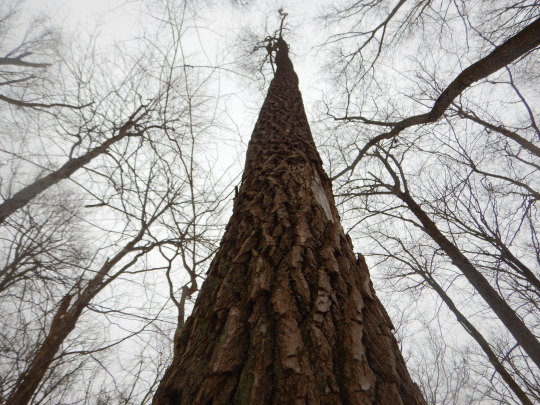
^old growth Fraxinus americana holding on but not for much longer( live vain only on left side of tree, right is dead from EAB crown growth displays this story all to well, This is also a good example of wiggle taper and forest taper vs. open savanna growth/ open forest growth. Still, most growth is only at the tip, when that remaining side dies the base may send up acute reaction suckers.
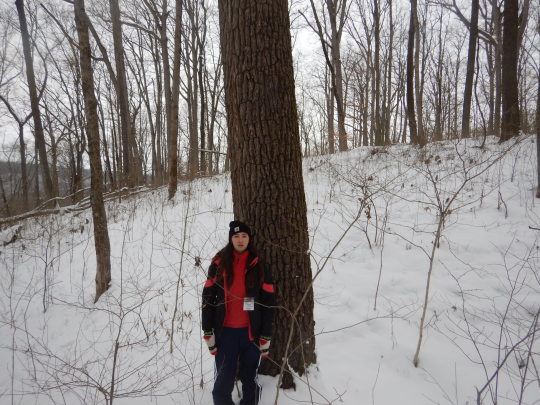
Versailles SP, IN, My friend Abby for scale, old growth, open forest grown, black walnut, Juglans nigra

same black walnut’s crown beginning to form as lower limbs abort due to canopy closure /Far red light reaction ( dead branch on left with branch collar as the termination point.)

The long unbroken ridges of bark of an old growth Northern Red Oak Quercus rubra ( look at crown growth does it occur inside branches or only at the tips?) (old growth trees stick to tip development).
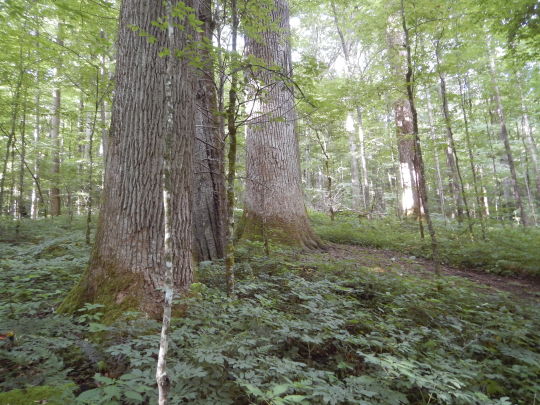
Joyce Kilmer memorial forest, virgin, forest grown stand of Liriodendron tulipifera, or yellow poplar/tulip poplar/ tulip magnolia/ tulip tree/ fiddletree by region.

^ me for scale.

“Oak-Hickory-Chestnut-Tulip Poplar” Climax forest but really it’s just virgin forest at Joyce Kilmer and it contains a lot of Virgin/old growth oak, hickory and tulip poplar, the chestnuts are gone and honestly some of the old growth sassafras and black cherry here are just as big as any old growth oak you’ll find anywhere due to the massive virgin tulip poplars being adjacent.
Forests that get old enough go through species succession to that is based on local climate delineating the types of trees found at the apex stage in my region many forest apex types are present Oak -Tulip Poplar-Hickory, Oak-Ash(not really anymore)-Walnut, Oak-Chestnut(well not really any more)-Pine-Hemlock, Oak-Walnut-Red Cedar(they can be late successional too), Burr Oak-Scrub, Cypress-Ash(again not really anymore)-Black Gum aka Tulipo, White Cedar-Hemlock-Oak-Ash(:/), and boreal matrix Beach-Maple-Oak up north. I don’t really like this way of defining apex forests because each forest is very unique at this point and has different land history and colonization history, categorizing early primary succession and early secondary succession forests by tree type may not always be the case. Many scrub oak savanna on barrens are truly apex forests, and many mixed talus fields with only red and white cedars are also apex communities so to call eastern red cedars an early successional tree species(which is very true) requires additional information saying (it’s not just that though) or people will place the tree out of context until seeing it in a different light.
Wolf trees are their own complex and can either be mature or old growth/virgin. Rather, are usually older second growth trees, or trees that one point existed in savanna but are now in new forest formed from succession, or remnant old growth woodland trees that existed for wind breaks, property lines, grazing shade trees, or were not selected for cutting when the forest that was previously there was removed for agriculture giving in time to react to new stresses, form strange reaction wood, grow new limbs due to these stress factors(wind sheer and sun scald on trees that were once grown in forests may not be able to survive on there previous taper or with there branch pattern since they grew in close forest cluster, the trees may end up growing adventitious laterals, (Chemical pathway induced suckers are different from water sports or water suckers which are instantaneous growth reaction to certain stress that form what some call ACUTE stresses(lightning, linesman shit ass butcher jobs, borer attack) vs. pathway suckers which form from long term stresses (reaction to changes in their environment that started out in an acute way but are actively present at all times through many years)), that offset the weight of the tree over time, cause shielding branches, and eventually fix the tree’s structural issues by being part of the same defense mechanisms as active buttressing root growth and hardening off each year. Wolf trees once these sites are abandon and are allowed to have company through succession, tend to hold on to their massive open growth newly formed crown and some of their strange, weak formed, laterals, for some time before re-adjusting if ever. Wolftrees are known to suppress vegetation when post ag or post abandonment succession starts. In some cases with the case of “Lonley Doug”, the span is so great that it only looks like a wolf at the top and wear it is wind flagged/ broken, the bark is thick enough and the holding wood is strong enough that new ecosystem modifications (aka damage/ destruction) have to really take time to even cause enough damage for secondary/ pathway reaction and growth.

Savana-> new forest wolf.
Second Growth mature, A mature stand of trees after a removal regime occurred, The age cap is like 150 or less in most states for these stands, many are often barely breaking an age of 100. 150 is really mainly seen in older states as the age cap. No tree is older than that and many are about that age.
Second growth early successional,
Very young and all very close in age. Virgin doug fir “lonley doug” and different back drops of different stages of clear cut second growth in the back ground :/ v sad. super shitty. Still going on in both USA and Cannada. This tree is in B.C.
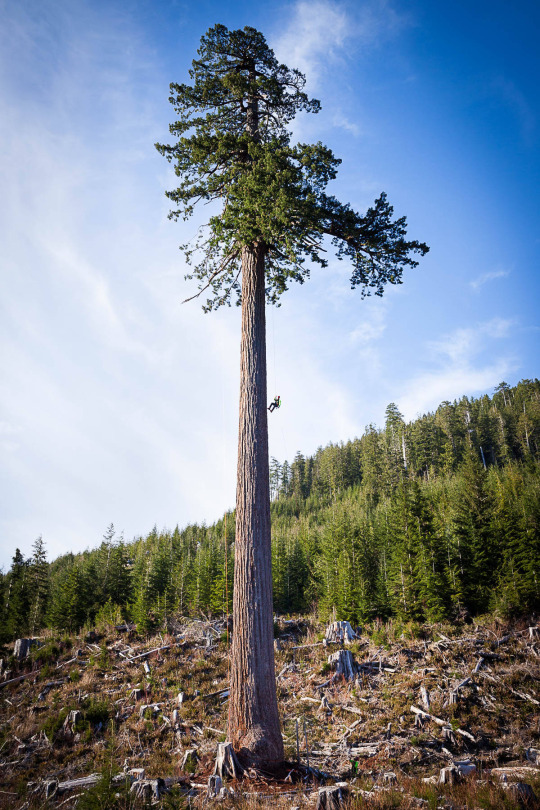
^climbingarborist is where this photo came from originally
Approximant dating:
The best way to tell a trees age is to get a sense of the species and to look at both the dbh(diameter at breast height), the placement of the tree, the reaction wood at the base, the taper of the buttressing roots, burn scars, site present and semi permanent ecology(local hydrology and soil texture stuff ect.), and the land history. It’s a complex of things that may help you only estimate a range of how old but gives you an idea without damaging the tree.
Core dating and delineation of age:
Age in trees can be displayed in many ways, carbon dating and boring radial cores can be considered hazardous to the trees health, especially with those species that can’t exude resin or are low in tannins. Boring, whilst appearing small, actively is damaging a site that will never grow that wood back, nor compartmentalize that tissue. active CODIT (compartmentalization of decay in trees) occurs along breakage axis at points where a branch collar has formed with certain limitations( limb has to be 1/3 the size of the main branch to have CODIT active prior to severing the limb or wounding). CODIT is also active along far red light dependent abortion zones and abscission zones. CODIT will never be active in the core of a tree; because there is no meristem to produce callus tissue( specialized collenchyma and parenchyma ground cell aggregates) to wall of other tissue, xylem in a sense is functionally dead water and dissolved nutrient tissue with the remaining substances deemed protoplasm due to there ability to sink nutrients and form channels through gap junction/plasmodesmata to transfer solution (basically just water with some dissolved Ions) in horizontal fashion (xylem rays). While some protoplasm/holding wood is sclerid and may have functionally became a heaving cell or perhaps even protoplast( plant cells that have been stripped of their cell walls through the action of targeting enzymes, pectinases and cellulase, in hardening off or during initial differentiation; they are still functionally dormant or “dead” cells that remain dormant for life with no change in tissue function. Since trees grow horizontally from the outside- out forming new wood to the inside as xylem and phloem complex to the outside prior to cork cambium ect. the tree cannot form new wood to enclose even the smallest bore hole. That wound becomes permanent.
20 notes
·
View notes
Text
The Ten Most Significant Science Stories of 2020
https://sciencespies.com/nature/the-ten-most-significant-science-stories-of-2020/
The Ten Most Significant Science Stories of 2020
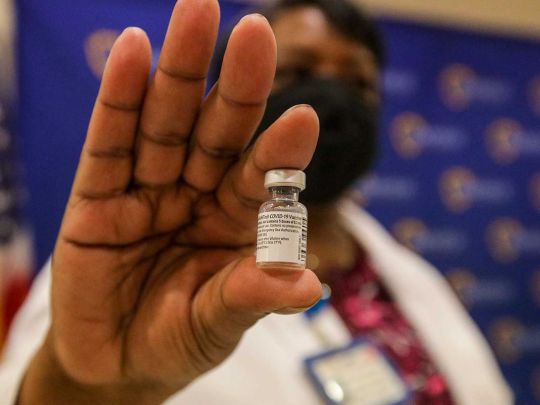
Covid-19 dominated science coverage in 2020, and rightly so. The world grappled with how to combat the SARS-CoV-2 virus, learning about how it spread (whether it was on surfaces, via droplets or being airborne) and how it affected the human body (from immunity to symptoms like loss of smell.) But scientific endeavors in other fields, whether affected directly by the pandemic or indirectly by public health measures, didn’t come to a complete halt because of SARS-CoV-2. In incredible advances, researchers used three new tools for making discoveries about the sun, discovered that dinosaurs got cancer and published a study on a discovery in a Mexican cave that changes the timeline of humans’ arrival to the Americas. But none of those moments made this list of the biggest science stories of the year. It’s a subjective round-up, of course, but one compiled by our editors after much thought and debate. Presenting the key innovations, studies and discoveries that made 2020 an unforgettable year in science:
Companies Develop Covid-19 Vaccines in Record Time

A vile of the Pfizer-BioNTech vaccine against COVID-19 that was delivered to Arrowhead Regional Medical Center in Colton, California
(Irfan Khan / Los Angeles Times via Getty Images)
Since the first case of Covid-19 was reported in China late last year, more than 802 million cases and more than 1.7 million deaths have been confirmed around the world. In the United States, more than 19 million patients have tested positive for the disease and more than 338,000 of them have died. While the disease continues to spread and cause death, help is in sight thanks to the record-setting effort to develop vaccines. In less than a year, Moderna and Pfizer, in cooperation with BioNTech, created the first messenger RNA (mRNA) vaccines ever to protect against Covid-19. An mRNA vaccine contains a synthetic version of RNA that tricks the immune system into thinking a virus is present so that it will make antibodies designed to fight the virus. This is different from a traditional vaccine, which is made of small amounts of an existing virus. The previous record for vaccine development was for mumps, which took four years in the 1960s, but Moderna started working on a vaccine in January and Pfizer and BioNTech began working together in March. By July, both companies began late stage trials, each with roughly 30,000 participants. In November, the companies declared their vaccines were more than 90 percent effective. By mid-December, the FDA approved both vaccines for use in the United States. National Institute of Allergy and Infectious Diseases director Anthony Fauci hailed the accomplishments as a “triumph.” Now comes the complicated, months-long process of distributing the vaccines to the public.
NASA Snags Its First Asteroid Sample
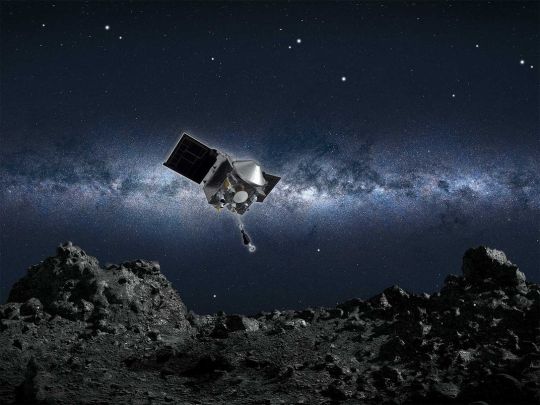
Artist’s conception of NASA’s OSIRIS-REx spacecraft collecting a sample from the asteroid Bennu
(NASA/Goddard/University of Arizona)
In October, the NASA spacecraft OSIRIS-Rex reached out and grabbed rocks from a 4.5-billion-year-old asteroid named Bennu. The mission, which took place more than 200 million miles away from Earth, marked the first time the space agency reached out and touched an asteroid. The craft was supposed to land on the mass, but the surface proved too rocky, so the team behind the effort pivoted to using a robotic arm to snatch a sample. The smashing success almost worked too well; the collection module vacuumed up so much rock that a vital flap couldn’t close. Scientists abandoned their plans to measure the sample and took days to implement an effort to successfully store the rocks. The sample should arrive on Earth three years from now. Experts think it may contain water and prebiotic material, the building block of life. Such evidence might offer clues about how life on Earth started.
Habitats Burn During One of the Hottest Years on Record
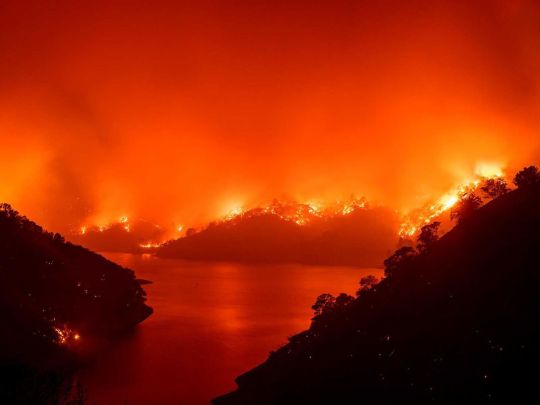
Flames surround Lake Berryessa during the LNU Lightning Complex fire in Napa, California on August 19, 2020.
( Josh Edelson/AFP via Getty Images)
As of the writing of this list, 2020 is in competition with 2016 to be the hottest year ever recorded. This possible peak continues a dangerous trend, with the ten hottest years ever documented all occurring since 2005. Perhaps no illustration of the effects of climate change this year was more dramatic than the preponderance of massive wildfires. Millions of acres in Australia, which was set up for disaster as 2019 marked its hottest and driest year on record, burned from last October into January 2020. Thousands of Australians fled their homes, and many animals died or scurried from their threatened habitats. In Brazil, fires ravaged the Pantanal, the world’s largest tropical wetland, from July through October. Roughly a quarter of the ecosystem , which is larger in area than Greece, burned. Residents and animals abandoned their homes for safety, unsure of what would remain when they returned. In the United States, California recorded its worst fire season ever, with more than 3 million acres destroyed. Massive fires have dominated the state recently, with seven of the most destructive burns taking place in the last five years. Hot, dry summers, due in part to climate change, have set the region up for longer, more volatile fire seasons.
Scientists Discover Signs of Possible Life on Venus, or Maybe Not
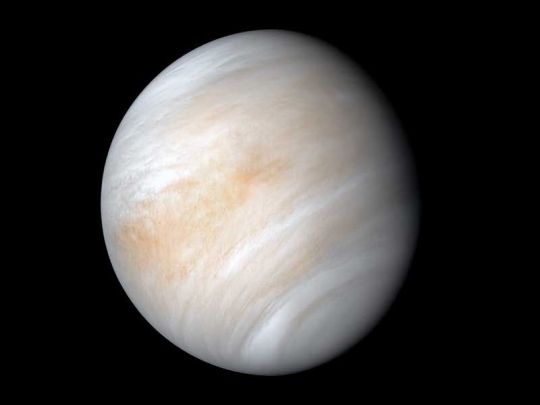
Venus is a world of intense heat, crushing atmospheric pressure and clouds of corrosive acid.
(NASA/JPL-Caltech)
In September, astronomers published a pair of papers saying they detected a gas called phosphine on Venus. They said the discovery, which was made using telescopes in Hawaii and Chile, suggested a living source for the gas because other conditions on the planet couldn’t lead to phosphine formation. News outlets from The New York Times to National Geographic picked up the story, while reporting that some experts were skeptical of the finding. In October, three independent follow-up studies failed to find the gas on Venus. One of the studies used new data, and the other two used the initial team’s original data. In November, the original team revised their figures and said that phosphine levels were seven times lower than their initial estimate. As the debate about the presence of the gas continues, the story is important not just because of the correction, but because of what it shows: Science is a process in which findings are presented and then opened up to scrutiny and revision.
Microplastics Invade the Furthest Reaches of the Globe
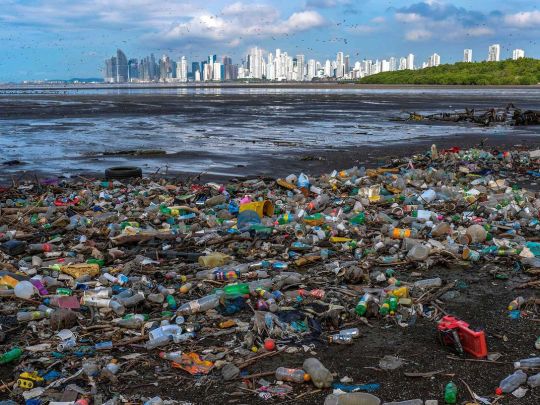
Plastic debris covers the beach of the Costa del Este neighborhood in Panama City.
(Luis Acosta/AFP via Getty Images)
News that microplastics have spread into many of the earth’s habitats is nothing new, but this year, scientists published several studies showing that the amount is much greater than previously thought and the reach is much further than previously documented. In April, researchers documented microplastics in Antarctic sea ice for the first time. In June, a study published in Science estimated that 1000 tons of airborne plastic debris rains down on national parks and remote stretches of wilderness in the United States. The country’s estimated contribution of plastic waste to the oceans was shown to be double what was previously thought. And in October, scientists published a study estimating that 15.8 million tons of microplastic are embedded in the Earth’s seafloor—or a lot more than is floating at the ocean’s surface. Not only the planet’s lowest points have been trashed; scientists published a study in November that found microplastics in every sample collected from the slopes of Mount Everest, with one such sample collected at 27,690 feet above sea level. Plastic debris has infiltrated Earth’s water, air and the living tissues of so many creatures, including humans. What scientists don’t know yet, is all of the ways the pollution affects us.
Three Different Early Humans May Have Lived Together in South Africa
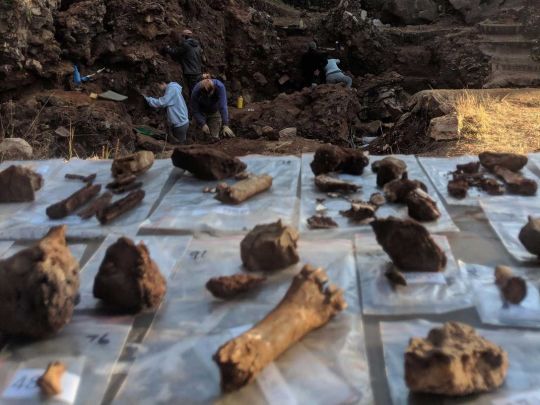
The Drimolen excavations and excavated fossils
(Andy Herries)
Despite being widely discredited in modern archaeology, orthogenesis—the theory that species evolve in neat succession, with new species replacing extinct species without much overlap—still looms large in the public understanding of human evolution. Researchers now say that evolution may have looked more like a scene first described in April this year, where three different species of possible human ancestors lived together in the same ancient cave in South Africa’s Cradle of Humanity. Tucked away in a roofless, amphitheater-like dwelling known as the Drimolen Paleocave System, skull fragments from Australopithecus africanus, Paranthropus robustus and Homo erectus were found to date back to 1.95 million years ago. This time period would mark the end of Australopithecus’s reign and the early beginnings of Paranthropus’s short-lived existence. Remarkably, the find could push back H. erectus’s origins by about 100,000 years; a cranium fragment scientists discovered might be the earliest fossil evidence of the species. Collapsed layers of fossil-packed sediment make precise dating tricky, but this study provides new evidence of multi-species hominin coexistence in a new geographic location, suggesting our ancestors were much more diverse than previously thought.
New AI Tool Cracks a Decades-Old Problem in Biology
youtube
Proteins are tiny molecular structures that make life on Earth go ’round. All proteins start out as a chain of chemical compounds called amino acids. Those chains then fold, twist and turn over and over again into perplexing tangles that eventually develop a three-dimensional shape. A protein’s shape defines what it can and can’t do—enter and alter certain cells, for example. When scientists can determine those 3-D shapes, the knowledge helps them understand how viruses spread, crack genetic codes and breakdown cellular infrastructure. Researchers have been searching for ways to crack the code of protein structures for 50 years. Scientists using existing technology require years of trial and error efforts to figure out a protein’s shape. This year, Google’s artificial intelligence company DeepMind debuted a deep-learning tool called AlphaFold that can determine a protein’s structure in a matter of days. The potential applications and breakthroughs this technology offers are numerous, including quicker and more advanced drug discovery. As one researcher described the find to Nature magazine, “It’s a breakthrough of the first order, certainly one of the most significant scientific results of my lifetime.”
The United States Is On Track to Eliminate Cervical Cancer

A pediatrician gives an HPV vaccination to a 13-year-old girl in Miami, Florida.
( Joe Raedle/Getty Images)
In a year plagued by a different kind of virus, good news is on the horizon regarding a form of cervical cancer associated with the human papillomavirus (HPV). Even without increased vaccination or screening, the United States is on pace to eliminate cervical cancer within the next 20 to 30 years, according to report released this year. When pap smears were widely introduced and regularly implemented at a global scale nearly a half-century ago, cervical cancer deaths began to drop. A vaccine introduced in 2006 prevented HPV infections that lead to cervical cancer. If medical professionals ramp up current vaccination and screening efforts, cervical cancer could be eliminated even sooner than expected, according to statistical models used in the study.
The United States Watched Washington Scientists Battle Invasive ‘Murder Hornets’
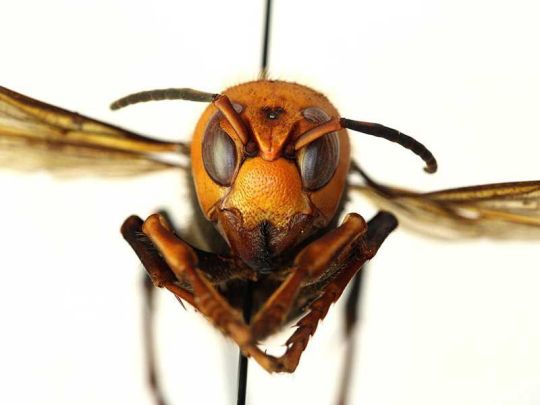
The Asian giant hornet, the world’s largest hornet, was sighted in North America for the first time.
(Washington State Dept. of Agriculture)
With a nickname like “murder hornets,” Asian giant hornets were hard to ignore, even though researchers spotted only a few at first. Asian giant hornets (Vespa mandarinia) decimate honey bee populations fairly efficiently (hence their nickname) and their sting is far mightier than any common bee found in North America. But after the New York Times published an article about scientists’ efforts to get ahead of the species before they settled for good in Washington state and British Columbia, the internet was abuzz with interest. Though four hornets had been spotted since fall 2019, it wasn’t until early October that the first live hornet was captured. By mid-October, entomologists found, isolated and incapacitated a nest that contained more than 500 “murder hornets,” including 200 queens. Though scientists may have arrived there in the nick of time, it’s impossible to know whether some of those queens mated and set off to start their own colonies, so a team is still on the lookout for the stinging beasts. All in all, the internet hysteria was exaggerated—and not exactly harmless either. Search engine inquiries about pesticides jumped, and common, oft-overlooked pollinators prompted panicked calls to local environmental agencies. One good thing to come out of the story? Folks learned a bit about the importance of controlling invasive species.
In 50 Years, Humans Have Decimated Two-Thirds of the World’s Wildlife

A leatherback sea turtle hatchling, an endangered species, crawls to the ocean.
(Mark Conlin/VW PICS/UIG via Getty Image)
Since 1970, 4,392 mammals, amphibians, birds, fish and reptile species’ population sizes declined by 68 percent, according to a World Wildlife Fund report released this year. Animals living in Latin America and the Caribbean took the biggest hit; their population sizes decreased by 94 percent. Habitat destruction is cited as the leading cause of these massive losses. The United Nations’ Global Biodiversity Outlook report produced similarly grim results. The document took inventory of 196 countries committed to recovering biodiversity as determined by the 2010 Aichi Biodiversity Targets. As dictated by the Aichi agreement’s ten-year plan, countries were to achieve certain recovery milestones like preventing the spread of invasive species and conserving protected areas. Most of the goals were not achieved or only partially met. Furthermore, the reports warned that pandemics, like the one the world is currently facing, could become more common if humans’ “broken” relationship with the natural world is not mended. In a statement, U.N. Convention of Biological Diversity executive secretary Elizabeth Maruma Mrema said, “the more humanity exploits nature in unsustainable ways and undermines its contributions to people, the more we undermine our own wellbeing, security and prosperity.”
#Nature
25 notes
·
View notes
Text
what do they eat????
the surface culture in KATAOW is Very Strange, and part of that strangeness is what people eat
when there was only one sapient species on the planet, humans, it was easy to draw the line between what was morally okay to eat and what wasn’t. broadly speaking, anyway. Don’t eat other humans; why? because they’re sapient. they’re people. just about everything else is fair game. humans will eat anything
not very complicated. and generally when humans thought about hypothetical other sapient species, whether they be mutants or aliens or whatever, they usually came to a similar conclusion: despite being a different species, the other sapients are still sapient, still people, and so would be off-limits, if they did exist. the What Measure is a Non Human trope does start to come into play here, because it is easier to question a being’s sapience if they are different from humans. But generally speaking, to humans, sapient = not a menu item
Here’s where things get complicated.
In KATAOW, humans are no longer the only sapient species on the planet. Far from it, in fact. I can name about thirteen just off the top of my head.
Now, if they were aliens, they’d have come from their own entirely separate ecosystem. Usually in media there is an unspoken “one sapient species per origin planet” rule. This rule is rarely broken. this wouldn’t be a problem, as long as all the sapient species agreed to not eat any other sapients. The more there are, the less likely this is to happen, but it’s not too much of a stretch to imagine, as humans usually do, that assuming the alien sapients have their own supporting ecosystems already, they could all agree not to eat each other, as a moral compromise if nothing else; a truce of sorts, a show of respect
Well. the new sapient species in KATAOW are not aliens.
They mutated, or evolved, from existing species in Earth’s ecosystem. In many cases (but not all) they seem to have entirely replaced their ancestors. For example, the Timbercats are the only example of modern ex-domesticated felines. There are no little kitties that can fit in a shoebox. None. None that we’ve seen, and Benson implies there aren’t any.
With birds, however, it’s different. We see examples of wild bird mutes (Beakbeak), and sapient bird mutes (Hummingbird Bombers). Is this distinction based on individual species? I don’t know.
In an inversion of the cat situation, the bunnies, or rather, megabunnies we see, are the only bunnies we see. But is it possible that there is now also a branched-off separate sapient species of bunny that we just haven’t met? I don’t know.
What causes some creatures to develop sentience, and others not to? They all seem to have changed in some way, but only some are intelligent now. Why? I don’t know. Humans seem to have, generally, been exempt from the mass mutation event. As we learn more about the world, this information may change, but this is what we know now.
Regardless, the fact remains that the creatures, the fauna of the world changed drastically, and with that change their needs changed too. Many plants and I would have to assume fungi and bacteria, archea, viruses, etc. have thankfully ALSO changed drastically. Is the ecosystem balanced, then, after such a drastic disruption? I’m not sure. The mutated life survived for 200 years though, so the environment coped well enough not to just kill everything, at least.
But still, food. Balanced or not, stuff definitely changed.
Let’s get the humans out of the way because they’re simpler:
Something happened to drive the humans underground, leaving a lot of food behind. They stay down there, so obviously they found ways to grow and hunt food down underground. If we can do it on Mars, a burrow is no problem. Humans were already eating whatever they wanted, so not much changed. And unless a lot has changed over 200 years, humans would still be averse to eating other sapient species. That’s been our history.
There are a few humans on the surface. Wolf implies that she won’t eat a mute if it’s sapient, when she first catches Mandu. Wolf and Benson seem to live off of old abandoned human food and non-sapient mutes. This works fine because there’s only a few surface humans; otherwise the supply of abandoned food would quickly run dry.
And that’s it for humans.
Non-sapient mutes will eat whatever, regardless of sapience. Beakbeak doesn’t care that his prey is intelligent. He’s an animal in the traditional sense of the word. Wild animals continue to be wild animals, just like before the mutation. Nothing new there.
But the sapient mutes? The sapient mutes are weird.
Just so we’re on the same page, here are a few sapient mutes we know:
The Mod Frogs, the Newton Wolves, the Hummingbird Bombers, the raccoons, the Dubstep Bees, the Scooter Skunks, the rats, some elephants, that waterbear/tardigrade guy, our insect bud Dave, the Snäkes, the Timbercats, Scarlemagne and his assorted primate gang, and those rodent ppl in Umlaut Valley--prairie dogs? Punk Prairie Dogs? Etc.
Quick note, there are a few that are questionable mostly for lack of information (Mandu, dragonflies, flies) and I’ll touch on them later. For now we’re working with indisputably fully-sapient mutes.
So.
Obviously their diets changed from their wild ancestors’, but I think we can assume that generally, their broad dietary range didn’t change. Strict herbivores are still built to handle plants only. There’s no reason their digestive systems and various feeding adaptations would have changed that drastically.
Herbivores? Probably mostly still herbivores. The Dubstep Bees seem to still rely on plant products, and don’t care for meat. Elephants are also obligate herbivores, and we see some with, what, some popcorn and cotton candy? That tracks.
For the sake of simplicity, I’ll be glossing over the fact that most carnivores I know do occasionally eat a bit of plant and can thus be considered technical omnivores. That’s not relevant right now. There are plenty of plants and none of the plants are intelligent, so there isn’t an issue.
Omnivores need a bit of both. Raccoons, rats, and skunks are our best examples. They have plants, so that’s fine. There seems to be enough variety of non-sapient mute prey for them too. These mutes are urban too, so just as their ancestors did, they supplement their diets with human food. There is no need for them to eat sapient mutes, and as far as I can tell, they don’t. I’m pretty sure most primates fall under this category too. Insects vary, but Dave seems to be an omnivore. Wikipedia tells me tardigrades go here as well.
There are some animals that are generally herbivores but occasionally eat meat, like Hummingbirds, but again, there seems to be plenty to go around, and no reason for those few meaty meals to be sapient mutes.
Carnivores. Yeah. I’ve been waiting the whole essay to write this part. Who’s left? The Mod Frogs, the Newton Wolves, the Snäkes, and the Timbercats. If they can’t eat meat on the regular, they just can’t survive.
The Newton Wolves, Timbercats, and Snäkes express their willingness to eat humans. The Snäkes also are implied to be regularly eating sapient prairie dogs. The Newton Wolves are known to hunt and eat Mod Frogs and humans. These are all hard facts.
Little bit more speculative here: The Timbercats, like irl cats, would probably be more keen on eating Snäkes if they weren’t so venomous. I don’t think they’d be opposed to it though. The Snäkes are large enough that wolf could potentially be a menu option. Wolves have historically been known to eat cats and snakes, so their sapient counterparts are probably fair game too. I don’t think the cats would want to eat wolves, though that thought is based largely on size and the fact that irl domestic cats don’t hunt irl wolves. Could they? Sure. I just don’t think they’d go for it when there are other options. Likewise, various omnivores would be considered prey to various carnivores, with practical and historical considerations determining their exact place on the food chain. Snakes and cats regularly eat frogs irl, so that’s that on that.
You may have sussed out my main driving question by now, but before I get to that, let’s take a little detour: humans as prey
No animal specifically hunts humans in the wild. We are not the prime prey animal of any species. Well, besides some bacteria, and a few parasites, but until we see a sapient bacteria or tapeworm, that’s not relevant. But these new mutated species, much larger and more intelligent than their ancestors, seem to see humans as just another prey option. And rightfully so! We are bald primates, just clever little mammals. Heck, even the rats are bigger than us now! If a mute would eat a rat, how different would human be? Different shape, but otherwise? Not much! I’m just saying I get it. Humans have been established as equal to other sapient mutes, and susceptible to the organization of the food chain in a way we’ve never been before. We’re not special anymore. We’re not even in power! We’re in hiding!
Now I don’t know, but I have to imagine that the reason several sapient mutes are okay with eating other sapient mutes is twofold: history and demand.
All these animals were, before mutation, accustomed to eating beings on a similar intelligence level. That was their normal. So when a few of them mutate and gain sentience, what reason should they have to stop what they’ve been doing for all of history? Inter-species communication isn’t new, just easier.
And demand? Demand is more speculative. All of the mutes are much larger than their animal ancestors. So they need more food. If their main food source grew as well, and wasn’t sapient, there’s no issue... until you keep going down the food chain and run out of what they eat, and so on... But anyway, that could be alright. No moral issue, certainly. If their main food source stayed small (intelligent or not tbh), there’s going to be a food shortage for the predator.
This is all VERY simplified, btw, ecology is complex as hell and I could spend years mapping out all the causes and effects here
Back to the point: if there’s a food shortage, you either find a solution or die. Predators are probably gonna want to hunt prey of an appropriate size. So they either find different prey, change their preferences, adapt as many animals have had to do for ages. Difficult sometimes, and a hassle, but doable. OR... if their prey did grow, but also gained sapience? Screw the morals, which are historically more human-based anyway, and eat them. For both prey and predator, it’s not very different from what they’re used to. It’s not new.
Alright. That all makes sense to me. So what’s the problem? What’s that big question? I’ll tell you what’s been bugging me:
What the fuck are the Mod Frogs eating!?
“Well Blue,” you might say, “Just big insects and stuff, right? There are dragonflies and flies in the show. Why should the frogs be any different from the other predators in the show?”
They shouldn’t be any different, by the logic of this whole essay, but they are.
All the other animals, I’ve been able to find reasonable food sources for. But then the frogs subvert the whole thing by having dragonflies and flies working for them. The two most obvious and recognizable prey animals for frogs. So, are they in some kind of weird servant-prey Stockholm syndrome relationship?
Okay, possibly. I don’t have any data to disprove that. But it doesn’t fit with the rest of the kataow vibe and also I don’t like it. Like, the predator and prey stuff I can understand, but that is a special kind of fucked up, sapient or otherwise.
So if not that, then that’s gotta mean the frogs aren’t eating them, right? Okay, that makes some sense, I mean, they use the dragonflies for transportation and the flies are?? Also transportation????? Or assistants??? Its unclear. How that arrangement came about, I don’t know.
Are the flies and dragonflies sapient? I’m not certain. The flies wear suits, so that’s a point for Probably Sapient. The dragonflies are largely treated as non-sapient but intelligent animals, like a domesticated horse. So maybe they’re like Mandu? Only they can speak. Dave knows and speaks their language. You don’t say “oh I speak a little Horse, lemme talk to them.” That’s not a thing. So the dragonflies for now are Probably Sapient, But It’s Complicated
Alright, alright, enough of that nonsense, there are plenty of bugs! Large ones too! And small mammals, irl frogs will eat those too! If they can get it in their mouth and it’s an animal, an irl frog will be willing to try and eat it. There’s no problem! What’s the point of this! They just eat big bugs! Just not flies because they’re sapient and--
Ah. Aha. No; see, that’s just it. Because they’re sapient. But hang on, didn’t I just say I wasn’t sure about the flies’ sapience? Yeah, I did, and I also said they probably are sapient, and even if they’re not, I have more.
ALL of the obligate carnivores in kataow reacted to Kipo’s gang in the same way; “Oh, that’s food.” And then only later, even if just a minute later, and usually reluctantly, “But maybe friends instead?” All the obligate carnivores EXCEPT for the Mod Frogs.
“That’s because humans are too big and--” Bullshit. Humans are the perfect size for mute frog prey. Sorry, that’s just a fact. And not only that, but they treat Dave and Mandu the same as the humans. Why? Why? Dave is a freaking insect!!! And the perfect size!!! And Mandu would be a great snack! Wolf almost ate Mandu, and she’s got a strict “if it talks it’s not food” policy.
Alright so I don’t have an explanation for Mandu besides “their sapience is uncertain and maybe that’s enough.” Maybe they’re too focused on the humans? I don’t know.
But Dave?????? When they captured him with Benson in the beginning, why didn’t they at least threaten to eat him??? Huh?? My proposal: because he’s sapient.
...So ...what?
So, if we go with this logic, the Mod Frogs are the only carnivores who care AT ALL about sapience of their prey. The omnivores and herbivores have the privilege of way more options, so they don’t get an opinion.
Why do the Frogs care? Why? And why is it just them?
This is where I run out of answers.
And yeah, there are probably other sufficiently-sized non-sapient prey animals for the frogs. There was a big spider and that’s probably enough proof for that point. They’re fine. They have stuff to eat.
But that doesn’t take away the fact that while they seem to choose not to eat sapient animals, none of the other carnivores do.
Why.
Is.
That?
Jamack caught a Dubstep Bee in his mouth and what did he do?? He spit it out! Why would he do that if sapience wasn’t a factor? Why?
Seriously though if you have answers PLEASE share them with me, I am absolutely bewildered
#kataow#jamack#mod frogs#newton wolves#umlaut snakes#timbercats#kipo and the age of wonderbeasts#kipo#dave kataow#analysis#biology#food chain#hunting#essay#meta#I got carried away....
147 notes
·
View notes
Text
The West Coast Trail; A Vancouver Island Adventure Of A Lifetime
Packing: Food/Clothes/Essentials | Booking: Reservations/Transport | Research | Facts | My Story | Start | Days 1 2 3 4 5 6 7 | Chez Moniques | Nitinaht Crab Shack
The West Coast Trail is one of the most, if not the most, iconic Canadian west coast adventure a hiker could ask for. It is a 75km test of both physical and mental endurance in one of the most stunning environmental settings you have ever seen. Not everyone that sets out for this great journey completes it, but those that do have a tale to tell for a lifetime and a forever bond with those they meet along the way.
Having completed this epic trail twice now, my approach is to blend a little bit of old and new into a (hopefully) wondrous tail that offers context, wisdom and insight to the journey, while describing the magical things you will experience and the challenges you will face. I’ve also prepared additional posts for your reading pleasure on Packing: Food/Clothes/Essentials and Booking: Reservations/Transport. So please, grab a hot cup of tea, throw on those comfy pjs and sit back and enjoy the read.
Handy References and Information Material
Every great hike starts with research, especially this one! If you haven't heard of it yet, look up the famed book Blisters and Bliss: A Trekker's Guide to the West Coast Trail by David Foster and Wayne Aitken. This awesomely 80′s comic styled guide adds a little light-hearted humour to a highly detailed account of the WCT which is revised roughly every couple years. It offers both trekking options (north to south AND south to north!) and gives you all the step by step nitty gritty deets in between including history, objects of interest, geological features and safety tips! I suggest taking it with you and read about the section ahead each night. Also, opt to keep it in a safe pack pocket, don’t put it in a plastic bag (I did this my first time and sadly lost my copy to the inescapable moisture and mold).
Check out the West Coast Trail Facebook Page! This page is not manned by Parks Canada. However, it is a great place to meet other hikers, find someone looking to ride share, ask questions and for advice, learn about recent developments and important information (washed out bridges, danger sections, wildlife sightings or concerns... even hear about annoyed hikers picking up others garbage...not kidding lol).
Oh! And there is also a Women’s West Coast Trail Page!
Parks Canada Website. Duh, right?! But you may not realize that Parks Canada has some handy info regarding what to pack (and what not to!), emergency items, wildlife warnings, necessary fees, maps, tide tables, tips and more to make your hike a happy one. Check out the Planning For WCT page here.
You'll also find online a plethora of websites, blogs and articles dedicated to WCT info, tips, advice, and more. I encourage you to read a few personal accounts to get a real life feel of what others experience. Here are some of my favourites (don’t let the names scare you!), plus a very cool and scholarly article from UofBC on the effects of colonial-style tourism in the area and on the local indigenous tribes written in 2020. Fascinating read.
Hike The WCT (website)
Walking the wild coast : territory, belonging, and tourism on the West Coast Trail (UofBC Open Collection)
Lost On The West Coast Trail
How Not To Die On The West Coast Trail
The Facts
The West Coast Trail is 75 km long. That's on the map and, best as I can figure, relatively "as the crow flies". It does not account for the extra steps, the ladders, the climbing, the crawling, the descending, etc, you get the picture. Both times I've gone my fitbit has read almost double or more the distance in 'real ground covered'. For example, when they say its 5km from the Gordon River Trail Head to Thrasher Cove, my fitbit in both cases recorded over 12 km when all was said and done. When they tell you it takes on average 5-6 hours to do that stretch, and you're only covering 1km or less an hour, this is why. You will chuckle in the orientation, as many have, and think, "ya, if you're a SNAIL!", but you will soon realize it’s about the terrain and that you're essentially doing double or more the physical effort to cross it. The same is true for nearly all the trail, even the "easy parts".
Safety First - the majority of accidents and injuries occur in the first 13 kms on the south side of the trail, from Gordon River at km 75, to Camper Bay at km 62. The trail accommodates just over 7500 people a year. Of that, Parks Canada evacuates roughly 80-100 injured persons annually and Nitinaht villagers have claimed to ferry out 100-200 additional hikers off the trail as well, due to injury, misery, etc. It won’t be a bear or cougar that takes you out, it’ll be the wilderness itself. A fall from a wet log or slimy stone is the most common culprit, and it may not even be the fall itself, but what you land on. Sharp rocks, jabbing sticks, etc all cause serious injury. And it always happens when you're TIRED. Don't push yourself. Take a break, have a snack, don't go farther in a day than your body can handle. Better to be a day late than waiting 24 hrs in the bush with no morphine and a broken leg for a boat ride that surely will be agonizing. Just sayin' here...
The WCT historically was maintained for shipwrecked mariners. Many have lost their lives along this trail. I don’t understand how it doesn’t have its own ghost story yet! It has an amazing history with lots of ship wreckage to see along the way if you time the tides right.
Lastly, the temperate rainforest that engulfs the WCT is not only stunning but globally very rare, encompassing less than 1% of ecosystems across the earth. Here you will see plants, trees and animals that may not exist anywhere else on our planet. The Sitka Spruce for example is among not only the tallest trees in the world, but also the oldest, some 700-1000 years old. This means they have seen North America as it was before European Settlers touched it. They are revered by many and highly sought after by loggers, which often leads to conflicts. Many extremely unique animals also reside in the WCT, like the islands' black bears which are actually larger than mainland black bears with massive skulls and only one unique colour phase. The island is also home to cougars, Victoria's famous mini-deer and sea-wolves, the only wolves in the world that have adapted to life on a coastline, they call the Pacific Coast home. With a completely unique diet of seafood they are genetically different from mainland wolves and have also been known to swim in the ocean for many kilometers.
My West Coast Trail Story
Now, before we begin, I'll preface this by saying, don't mistake me for a pro; I am simply someone who has made it off the WCT twice [relatively] safely and lived to share my tale. If you are looking for expert advice I'd say check out the Parks Canada website or the Blisters and Bliss book. But if you are looking for a heartwarming and informative, real life account of the experience, you've come to a great place.
I am now amongst a lucky few that have had the enormous privilege to have hiked the West Coast Trail not only once, but twice in my lifetime thus far. I say thus far because this trail has such a special place in my heart I expect at some point I will likely attempt it again. It changed my life and has had an everlasting impact on the lives of those around me. I learned a lot about myself and even more about those closest to me. What I am capable of, the importance of preparation and planning, the bonds you create with people you meet along the way and the love of those that support you going and take care of things while you're gone. I simply couldn’t have done this without the support of my amazing husband, friends, parents and sister and my wonderful sister in law whom we stayed with this time. But most importantly I missed the encouragement and support of my mother-in-law who lived on the island and sadly has passed since my first trip. She and her friends played such an instrumental role in my first journey with my sister, buying us foods, housing us, driving us, and just overall being so excited to see us off, I truly missed her this time but I know she was there with me in spirit.
In this way the West Coast Trail is a life-shaping experience like no other. You will learn much about yourself, be in awe and hopefully inspired by the incredible natural world around you and you will meet fellow Canadians and global trotters and, in turn, become a part of their WCT story. Let me be amongst the first to congratulate you on this epic endeavor and wish you the happiest, and safest, of journeys and hopefully I can send you off a bit more well prepared for the adventure.
First Timers VS Second Timers
My experience as a first time WCT hiker was extremely different from my second expedition in every way possible.
The first time I hiked the WCT I went with my youngest sister Jenna. We had both hiked and camped before but this was a new experience and everything was raw, a bit scary, amazing and beautiful all at once. I think it just hit us both like a ton of bricks when we landed at the base of that first ladder across the Gordon River. Although Sharon had talked to me for months, mentally preparing me for the hike, when Jenna and I both looked up at the rest of our start group scaling that first beast, looming up from the small beach landing, I know we both had the exact same thought, like, "oh shit, this is for real...".
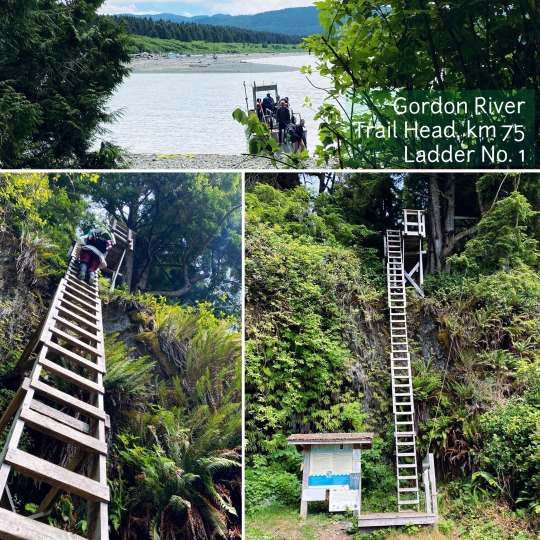
Why the WCT? Sharon, my good friend and co-worker, had previously attempted it before turning me onto it. Due to an unfortunate incident with her hiking companion, they had to turn in the towel. She has since rocked it twice more and was an absolute wealth of information, support and the wisdom that only an experienced female hiker, mom and athlete can be. Much of what I am sharing with you today began with her. She continues to inspire me every day with her ferocity and determination and boundless want for adventure.
At the time of my first hike in 2016, my mother-in-law lived on Vancouver Island and she and her best friend Jill had kindly arranged for us to stay at another friend's cottage just outside Port Alberni. The friend and her husband fed us well and the beauty of the setting was unimaginable. But the anticipation of what lay ahead weighed heavily on both Jenna and I and neither of us barely slept a wink. The next morning we had our last hot shower and flush toilet experience for the next 7 days and the 4 of us set out for the Gordon River Trail Head.
We piled into Jill’s car the following morning. The ride was long, on gravel switch back logging roads, but the supportive company made the nervous anticipation bearable. I feel like I did not appreciate the ride as much as I should have at the time, but a few 5 am bus rides (and much experience) later, I certainly cherish the thought my mother-in-law and Jill had put into making the beginning special for us both.
Since then, I've booked my island hike transports with the West Coast Trail Express bus. The folks there are super helpful and the experience has always been a good one. In 2018, a WCT facebook group was created which has made connecting with others looking for ride shares and doing the trail much easier AND more informative! You can read about this page and other research options at the top of this post if you missed them ;)
When 2016 saw Jenna and I land at Gordon River's Information Station, I was greeted with an amazing surprise... Sharon and Jackie (another friend) had pre-purchased for me a WCT t-shirt. I cried, there were no words. When 2021 saw Krista and I land at Gordon River's Information Station, I was greeted with a sense of the familiarity of the adventure and vicariously enjoyed the wonder of someone else now experiencing the trail for the first time... READY?!.. and INHALE... can you smell it..? the Adventure?! It's like greeting an old friend again, for the first time.
It's Like Those Choose Your Own Adventure Books, Where You Pick Your Ending...
Remember those..? Maybe..? When Starting the WCT, you can plan to start at either entry point, Gordon River to the south or Pacheena Bay to the north, or now even halfway at Nitinaht. There are advantages to all, so it just depends what is most appealing to you. Most people do the trail within a 6-8 day time frame. This gives a good balance of time vs pack weight. I always try to plan for an extra emergency day, just in case. Things happen here... Long stays requires more provisions and a heavier pack. Shorter stays (in my personal opinion) are extremely challenging, unless you have done the trail before, are very skilled in lightweight packing and are an expert hiker. I still wouldn't recommend it. Plus, if you're going that fast, you're rushing by so much, what's the point? If you've paid and taken the time to be here, enjoy it! That being said, when Jenna and I did the trail we were treated to watching marathoner and athlete Jen Segger run it in one day. ONE DAY. She currently holds the women's record for WCT completion at 13 hrs 44mins (as posted here on her page under 2016). Of course she had no pack and support runners with her and a camera crew. But as she ran by us I think both our jaws dropped. It was like watching Super Woman run by you and you were just lucky if her sweat spayed you as she passed by.
When you start out, keep in mind your pack is at it's heaviest. Starting at Pacheena Bay entry point means you'll be hiking the easiest parts of the trail first. You'll make excellent time here and cover the most distance over the shortest number of days. Although all areas of the trail offer exquisite and unique beauty, in my opinion the north end is the most magical. Maybe because by the time I reach it Im half delirious and most certainly exhausted so the easier hike is a much welcome break. Both times I've hiked the WCT I have opted to start at the southern trail head point known as Gordon River.
Starting at Gordon River means that you get through the most difficult terrain right at the beginning, when you're freshest, well rested and eager to set out. You also have the added benefit of anticipating the terrain getting easier (rather than harder). To me, this is the most logical approach and why I prefer this route and honestly, there is just something that seems slightly disillusioning about expecting something to get harder along the way. When Jenna and I first made it up that initial ladder we came across several groups finishing their hike. One in particular stuck out, a group of three female friends. We passed the first two who were happy and chatting and weirdly gave us a (mild) warning to disregard their companion, who was somewhere behind them. Ok... sure, we thought. Then along came the third girl... muttering, swearing under her breath, we contemplated what she might do to her companions if she caught up to them and we joked about how that likely was the end of that friendship. 2016 was a much busier year, pre-covid and all, and we met so many more people, Canadians, Germans, Chinese and Auzzies!
2021 though is the year of the Canadians! If you happen to head out on the WCT this year, although you will still experience a wide range of people (Canada is an extraordinarily diverse nation!), rest assured most currently reside within Canada. Hello Homies! It was, however, a much more muted WCT experience than my past one. Although the Parks staff assured me they have had lots of people come through (I asked!), and the online bookings are sold out, it seemed so much quieter day to day. At the time Krista and I arrived, Parks staff were still only doing outdoor basic debriefing, prior to which we were expected to watch an online information video covering the basics. This was in stark contrast to the very in depth orientation Jenna and I had to attend back in 2016.
Fellow Canadians, Tsk Tsk...
The biggest difference I noticed that could be as a result of the minimized debrief is the amount of garbage. There is NO garbage removal on the trail. Parks staff DO NOT haul garbage out (its a remote wilderness, do you really expect garbage men??). The WCT is accessible by foot (as in, you hike in... for 75 km) OR by boat, the latter being weather and safety dependant in extreme occasions (ie emergency evacuation). At each campsite we stayed, hikers THIS year (the trail was closed 2020) have left copious amounts of garbage. It’s in the bear bins, on the trail, the beach, in the outhouses... it’s EVERYWHERE. The worst by far was Camper Bay with stinking tuna cans and bags in every bear bin and Cribbs Creek, where the garbage pile extended to a massive bottle collection BEHIND the bear bin.
Why do sites have bear bins in the first place? Because human food and waste smells amazing to BEARS! So we lock it away to keep it, and us, safe. This does not mean a bear can’t smell it, it just means they can’t access it. Now, what happens when food rots and gets stinkier...? Of course it's more enticing. This draws bears, and other animals, to the campsite, which puts your safety, and the safety of each camper, at risk. I have to give Krista major kuudos here because that girl dug in deep, cleaned someone else's mess at each site we stopped at and even hauled out other people's stinky gross trash. Please give her a round of applause for thinking about you because she deserves it. And as Canadians, seriously, we can do better right??
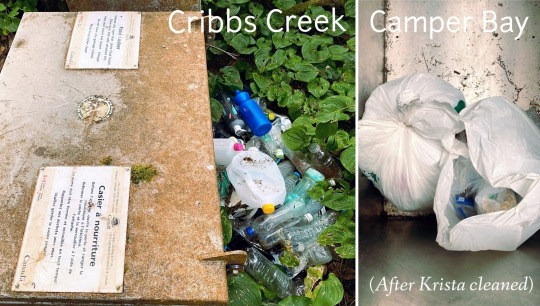
Da' Debrief
Apologies, now that’s out, let's get on. During our debrief we learned some important key points.
2021 has seen unprecedented amounts of animal sightings and encounters. Primarily bear and cougar. There has also been more daytime sightings of wolves, which is considered extremely rare. With the trail closed in 2020, lack of human presence has caused a larger wildlife presence. Be aware, practice safety, travel in groups. Groups are also being asked to accommodate single hikers to reduce risk.
There is a lot of maintenance to be done that wasn't able to be accomplished in 2020 due to the pandemic. Be prepared for washed out boardwalks, bridges and rotten boards. There is also fewer Parks staff to help with this upkeep. Luckily, local members of indigenous tribes, called the Trail Guardians, historically help in a huge way with this and you may even run into them on the trail! We saw their team arrive in their new boat leaving Walbran and at Pacheena we spoke to a Parks staff who's uncle is on the team. It's a small world here.
Following the debrief, the Parks staff escort you to the Gordon River ferry. The fellow here takes you across and plops you down on the small sandy beach, gathers up any hikers waiting for a ride back and heads off on his way. And there you are, left to stare at a huge ladder, really, the first of many.
up, Up, UP You Go!
In 2016 Jenna and I patiently waited at the end of the line to be the last two up the ladder and I tackled the climb with my 50lb pack in tow (phew!). In 2021 Krista and I were the only two standing on the beach, me revelling in my 'barely there' 38lb pack. The trail was our oyster!
The trek from Gordon River to Thrasher Cove is the most challenging and physically demanding on the trail. We left on the 11:30 ferry and finally walked into Thrashers Cove at 5pm - Yes, it DOES take that long. You actually don't see many ladders, a few here and there, but best believe you are still climbing! You scramble up rock faces, you squeeze past trees, you choose your footing extremely carefully and all the while up, up, UP you GO! Even over rocks and hard ground the trail is fairly well worn and easy to follow... most of the time. A short while in you come to the first bridge over the first creek. I have stopped here both times to fill up water bottles, but beware, the scramble back up is more difficult than it looks this year due to the fallen trees. Mountain Goat level scuttling expertise is advised! Much further along, not far from Thrashers, you'll eventually comes across the famed Donkey Engine! This year you will find it to be directly in your path, where as in 2016 I’m quite sure we looked down on it somehow from a higher elevation. Either way, it’s epic and makes for an amazing photo op! To think that thing was hauled by beast and hand up that hill still blows my mind.
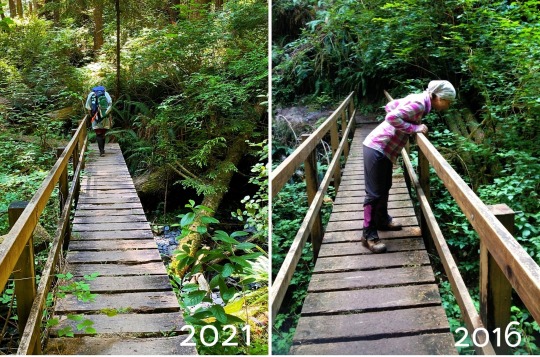
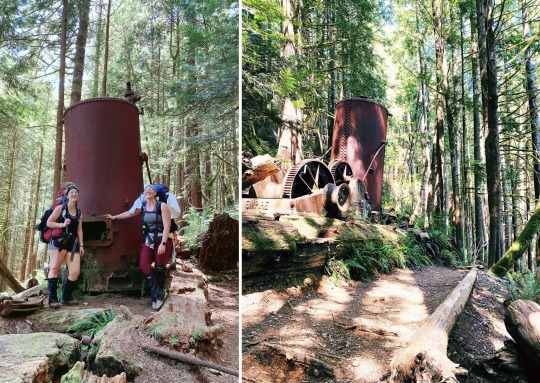
Along the way we met a very nice gentleman named Wilson who had intended to hike the WCT with his son. Unfortunately, due to a graduation re-scheduling mishap his son was unable to come, but Wilson decided to soldier on. He was incredibly happy, thoughtful and polite and asked if we minded if he tagged along as we hiked. He regaled us with tails of his trails, immigration to Canada, his wife and family and much more; he was a fascinating fellow! With the wildlife warnings this year, Parks staff request that no one hike alone, if you can, allow a solo hiker to tag along so everyone can stay safe. We graciously obliged and enjoyed his company and great conversation for a couple more days until we parted ways at Nitinaht comfort camping.
Thrasher's Cove is an amazing, but small, campsite. I recall vividly in 2016 the trail down to the beach being extremely treacherous, with steep and slippery embankments and so many ladders! By comparison our 2021 descent seemed like a cake-walk. Here I was, boasting to Krista the challenge that lay before her, but when we got there it was literally a quick hop and skip down. She found anything I said after that to be hard to believe and was convinced I was totally embellishing. It really made me realize how MUCH the trail changes and what dynamic metamorphosis must have occurred in 6 years! I also realized how hard Trail Guardians and Parks staff must work to maintain all this constantly worn out infrastructure. It must a BEAST. Be warned, if you arrive to Thrashers too late in the day it will be tough finding a spot. If this happens to you, check out the south side of the beach, sometimes there's a bit more space there. Ironically, I have set up my tent in the exact same spot both times, right in front of the tiny triangle cave around the rock wall on the south side of the beach. I have claimed this spot now.

Knock, Knock, It's The Ocean!
This is also where knowing how to read your tide tables is extremely important. While camping on the beach you must pitch your tent above the high tide line. The high tide line is where you can see the sand was last wet on the beach. It's not where the water is when you arrive. Look for the wet point on the sand and keep your tent a few good feet above that. When Jenna and I first arrived at Thrashers, I was confident in my tide table reading skills; being from Alberta, I took the time to learn how to read them in advance. But, during the orientation the Park staff had warned our group that our first night was due to be the highest high tide of the year - intimidating to a couple prairie girls! And, which is also a thing if you read up on the moon cycle! (Actually there is a lot of news this year on the effects of the moon's impending orbital wobble on tides, its a fascinating read if you're interested!). So, naturally a bit cautious and overly leery of the horror stories of campers waking up to soaked tents in the middle of the night, my poor sister was worried sick. Exhausted but too afraid to sleep, I promised her I'd stay up till high tide to make sure we were safe. She soon passed out and I settled in reading my book. But the surf was loud and near, a thundering, crashing rukus with each wave and about 2 hours in my sister jolted straight up in her sleeping bag, scaring the ba-geezus outta me crying out 'IS IT HERE?! IS THE OCEAN HERE YET?! ", big-eyed I just stared, then broke out laughing; I settled her back down, reassured her we were safe, now passed the time of concern, and wiggled down into my own sack to drift off. It's still an inside joke to this day and once in a while we chuckle to each other about the time the ocean came knocking.
2021 brought me its own surprise when at 4am I awoke to an unusual scratching noise against our tent next to my head. We had wrapped our rain covers around our [empty] backpacks and snugged them up against the tent to stay dry and save space. Apparently the local otter family found them fascinating and decided to check them out on their morning stroll. An alarm clock certainly fit for the WCT.
It's A Beach Walk, Not A Cake Walk
Leaving Thrasher's Cove you have two options! You can take the beach route if you time the tides carefully OR you can take the inland route. In 2016 Jenna and I sojourned the inland route. Although the inland hike was pretty, if I'd found the trek down to Thrashers tough, the trek back up would've been classed insane. Sharon’s favourite saying is, what goes down must go up. In 2021 Krista and I timed the tide, leaving at 7:30am, to take the beach route. Although we'd planned to avoid what turned out to not be a bad climb, I'd really wanted to see the famous sea caves! The sea caves themselves were nothing short of AMAZING. There is just no other word. I was so in awe that in my mind they seem to take up almost 3 days of our trip, not just half an hour on the second day.
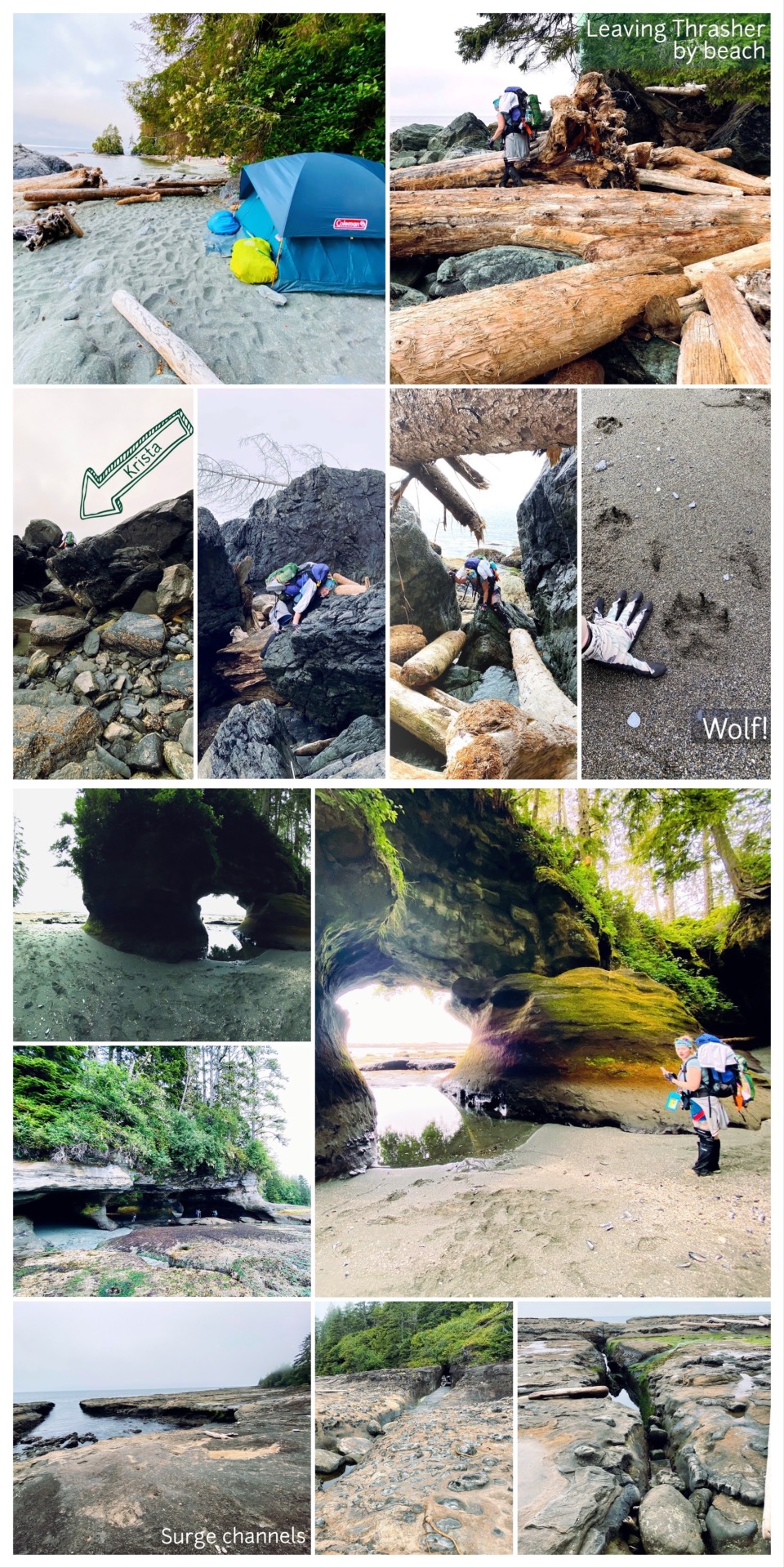
Although we'd planned to aim for Cullite Creek Campground day 2, we hit a major snag. As we traipsed along, well after the sea caves, we came to a rocky sea shelf that rose high out of the water. As you look up, you might catch a glimpse of some buoys, which commonly mark the beach access to the trail and campgrounds. Thinking this was our access back onto the trail, as you must go inland from here to Campers, we headed up along the higher shelf. We passed an unusual 'Danger' sign. We looked around, but could not identify anything that seemed out of the ordinary for where we were. We kept on. We came to a similar sign on the rock, but again, failed to see what was obviously dangerous. Wasps? Bear den? Surge Channel? There was no fallen bridge, no down ladder. Everything seemed ok. We reached the buoys, and Krista lifted her leg to step over a small trickle of a water... That's when it happened.
Danger on the Trail...
Before she could even complete her step, both feet flew out from beneath her and her whole body, pack and all, smashed onto the rock shelf. She began rocketing like a she was on a pro waterslide down the embankment towards a 9 foot drop into the water pool below. I had the wherewithal to shout out 'grab a rock!', and in the 3 seconds that seemed like 3 hours, I had the presence of mind to ponder how I might explain this to her mother back at home and 4 year old son if things went sideways... but with a 38lb pack on myself and being a few feet behind, there was no way I could move fast enough to do anything but yell.
Luckily, mid-slide, she managed to grab a handhold just long enough to stop and get some footing. Crisis averted, but the damage was done. Wearing shorts, she was sporting some nasty road rash on her cheek and arm, but most of the damage was buffered by the hoodie she'd had tied around her waist. She was bruised, but she was lucky.
Feeling pretty roughed up, we opted to stay at Camper Bay instead and rolled in about 1pm where we washed and treated her ailing buttocks and gave her some much needed pain meds. Along came a few more groups and we felt a bit less sheepish learning 2 of them had also had the exact same experience. Pride slightly less wounded, we made some new friends for the chatter and laid back and chilled for the afternoon. On your parks provided trail map, you will see a small note in red pointing to BA 'B' (beach access B) that warns about a dangerous slope just past the surge channels after Owen Point. It's not kidding.
If you stay at Camper Bay, it's a lovely and large campsite with lots of room for everyone. However, it has a habit of getting very windy, like all the time, and the only time it's not is when the sun goes down. If you're early enough, grab one of the sheltered tent spots in the woods/taller grass along the creek side. It also has a rep for early morning rain and fog. Something about the geography here seems to create its own micro-environment. If you walk out along the beach at low tide and cross the creek to the north, you'll see some neat tidal pools and caves in the rock wall. In the one with the small pool of water you might see a single lonely fish with the pool all to himself. I hope one day the tide washes him in friend.
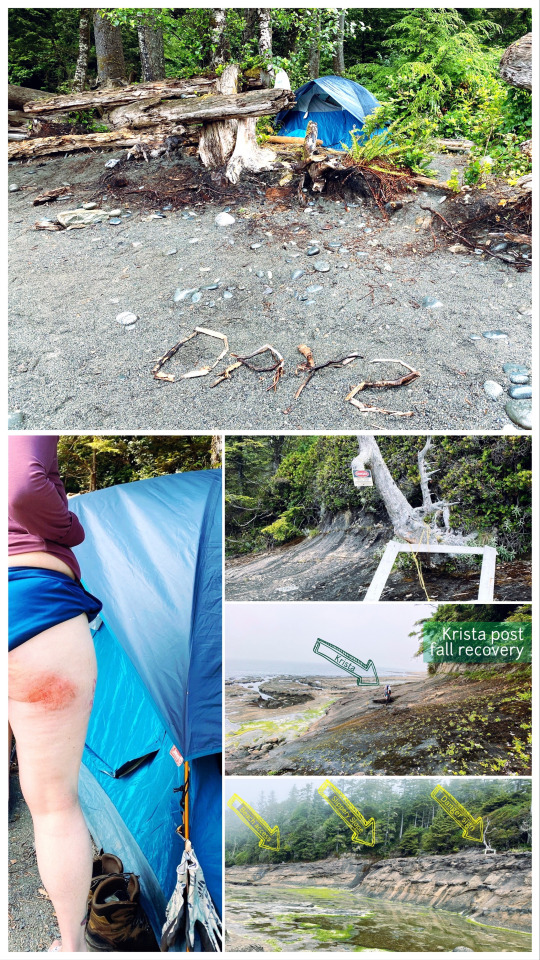
Reminiscing...
Ironically, day 2 in 2016 was also the day I had a mishap of my own. Tired and worn down, toddling after Jenna across a log bridge the width of my car, I misstepped. My feet were somehow gone and in a second I found myself sitting on my ass, straddling the log instead of walking on it. I peered down into the 6 foot drop below. Completely in disbelief I suddenly realized Jenna was yelling at me "Are you OK?!" ... Yes! I was! I was ok. Nothing was broken, hurt or otherwise. But it was a wake up call. If you are tired, take a break, don't push on or try to keep up with someone faster. Only hike as fast as your slowest hiker and be patient. Take a breath and remember, the goal is no one dies out here... hopefully.
Gone Are The Days Of Legendary Mud And Tilting Ladders That Make You Poop ... Just A Little
The few days that followed are a bit of a blur. There's so much to see and so little blog space to include it all! We left Campers Bay on a foggy, rain mist morning at about 10am. Since we had to take the inland trail there was no worry about racing the tide on this stretch. We chatted with the couple we met the night before (Mat and Lauren from Calgary!). Everyone was a bit tired that morning.
Although we saw some mud, with a historic heat wave just prior to our trip in 2021, the legendary mud pits that the WCT has typically been known for were non-existent. In 2016 Jenna and I spent most of our inland trail time figuring out how to cross mud-holes, watching where each other stepped and trying not to fall in up to our armpits (I kid you not). This time, there was no mud and if you disagree with me, go again after it rains. I dare you.
This is also the section where we saw the most ladders, most notably through Cullite Creek, which was sadly such a trickle there was no need for the cable car, we just rock hopped across (with ease). We saw some really cool art done along the trail by the Guardians in the new bridge and log cuttings, some even signed their names! Have you tried making a curve with a chainsaw? I was impressed.
This section also has a neat and unique stretch of boardwalk that goes through a fragile wetland. Sections of the boardwalk were out, it looks easy, don't let it fool you!
A brand-spank'in new suspension bridge calls Logan Creek home! In 2016 Jenna and I had to climb a harrowing series of crazy, half-tilted ladders to get to the bridge. I recall my favourite as being the third ladder in a tower, that was so amazingly on a 10 degree angle sideways, and scaling it with my 50lb backpack. It was all I could do not to roll off and meet a perilous end at the bottom of the gully. Today the beautiful new bridge almost disappointed with the ease it took to cross it. NO more ladder climbing, you just walk up the stairs and off you go!
We arrived in Walbran Campsite at 5:30, the creek is perfect for swimming if it’s warm enough. Several groups had a run-in here with a couple breaking the fire ban policy. People on the WCT take this seriously, keep in mind if you start a forest fire here, there’s no where to go and it puts the homes of indigenous peoples at severe risk too. We all simmered, had a tasty meal, chatted with our travel companions, explored the beach a bit and turned in for the night, thoroughly exhausted.
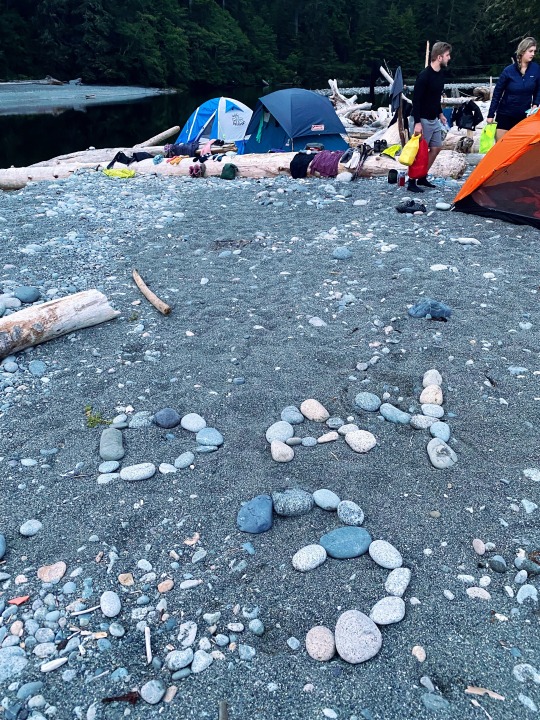
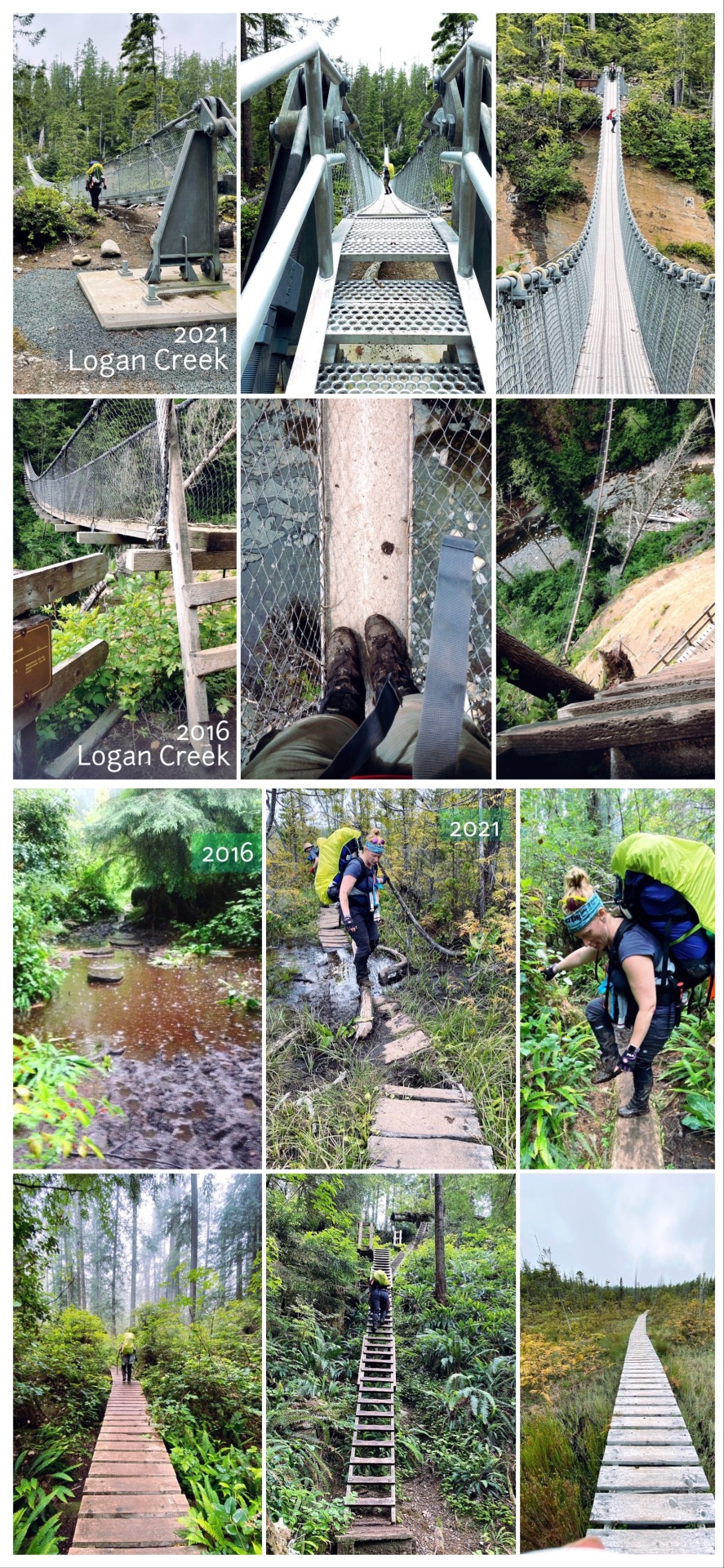
We spent the next two days going from Walbran Campsite to Cribbs and then to Tsuisiat Falls. Due to a problematic and confrontational cougar in 2021 there is no camping permitted along the trail between kilometer 34 to 38. So, naturally, your last stop prior to Nitinaht Narrows is Cribbs Creek.
The Stretch from Walbran to Cribbs is basically all beach walk. The beach is lovely, but don’t let 'beach walk' fool you. It’s just as challenging to walk in sand as it is through forest... and you thought it was going to be easier, didn’t you?! It's like walking through snow without snowshoes and being 30lbs heavier...what a Canadian thought. But! Fear Not! along this stretch is also the famed Chez Moniques burger stop and the Carmanah Lighthouse! The lighthouses are closed to the public this year due to covid, but it’s still a sight to behold as it beams brightly through the fog.
The Legend That Is Chez Moniques
In 2016 Jenna and I made a critical, but common, food planning error. We packed meals based on what we felt was healthy and would give us energy, without accounting for taste. In other words, we packed a lot of dry lentil-based meals that tasted awful and took forever to cook and I couldn't have forced down my throat if you had paid me. I love beans, but dried lentils on the trail... yech! You can read more about our cautionary tale in my food section, and if you're uncertain about foods to pack, it’s worth the read!
So, sufficed to say, that year we had the absolute pleasure of experiencing Chez Moniques in it's prime. It was incredible. Here we were, in the middle of nowhere, exhausted, starving (I was anyway lol), and run off our feet. And out of nowhere arose this mirage of a tent with burgers, fancy meals, peach ciders and more! My god it was intense. We kicked off our boots, stuffed our faces, chatted with Monique, the legend herself, and I protectively cradled the best Okanagan Cider that had ever touched my lips while we waited for the tide to recede. It was magical.
Sadly, between 2017-2018 both Monique and her husband tragically passed away. It was a blow felt around the world by all those who had passed through their doors and experienced their generosity. There is a lovely documentary attributed to their memory here. Today, in 2021, following a devastating 2020 with no business, Monique & Peter's grand-daughter, Katrina Knighton is trying to carry on the dream though the restaurant will be renamed as Nytom. We heard lots of chatter and some hikers did actually see her in person, but unfortunately there are some struggles, including keeping up supply levels, which they are walking in for 1.5 hours (!). We missed them this year, as did many hikers, and I was so sad Krista would not experience it. But! They are rumoured to have services most often morning and around 5pm. Katrina is also very active on the WCT Facebook page, so feel free to drop her a line there for more info!
We arrived in Cribbs Creek at about 2:30pm. It was the end of our Day 4 and what a campsite it was. Lovely soft sand under your toes and beautiful beach. There is nothing here for swimming but we had the most amazing sunset view on the rock shelf that night. Although it didn't rain while we were on the trail, this was the first time we'd seen the sun since we left Victoria.
youtube

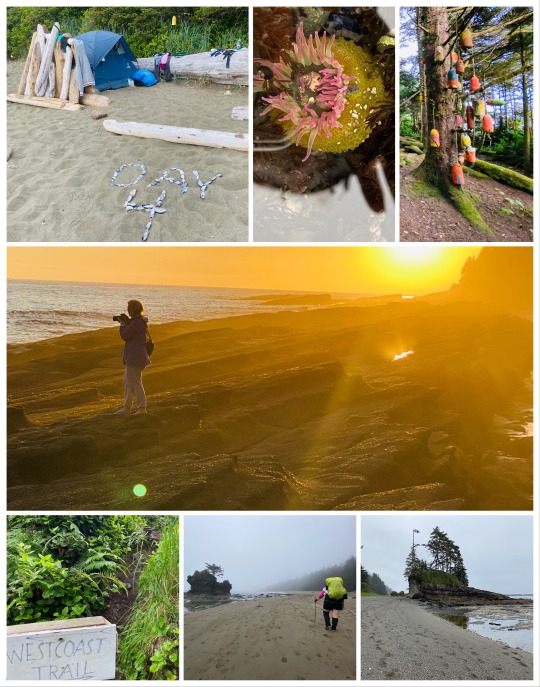
The Magical Beauty Of Nitinaht And The Crab Shack Of Your Dreams
We left Cribbs Creek about 9am and stuck to mostly inland trail. Other hikers going the opposite way had warned it was very overgrown but we honestly had no problems with it; it was a little underused, but keep in mind they hadn't seen the south side yet. We made excellent time and arrived in Nitinaht Narrows at 1:09pm. The journey is absolutely stunning. There is a new bridge over the creek at Dare Beach and the forest walk is lovely. The bridge over the Cheewhat River offers great views also. You cannot take water from the river itself but after the bridge there is a freshwater stream marked by a wooden sign if you need it and soon you will come across an old Cabin. When you arrive here, turn around and see the new and amazing Ditidaht home across the river. It has changed a bit, likely with the drought, but in 2016 Jenna and I referred to this stretch as "the place that Disney films are based on". Ivy clung all the way up the trees and just as you wrapped your head around that, the trail winds it's way through a silent coniferous forest where you could almost hear a pin drop, followed by a magical wetland lake with flowering lilly pads the size of your head. But none of this compares to Nitinaht Narrows.
As you walk along the trail, just a few short minutes past the lake, the path will turn from boardwalk to dirt and as you round the bend you will suddenly walk, with no warning, right into Nitinaht! It has caught me by surprise each time. We strolled down the walkways to the dock, left our packs safely on the bench and made our way to the Crab Shack. The blue-green waters of Nitinaht Narrows is something to behold. When you peer over the side of the wharf you see schools of small fish so thick you could almost surely touch them. When I dream of paradise, I dream of here.
Nitinaht Narrows was only recently made an 'official' entry and exit point by Parks Canada in 2014, you can read more about it here. But prior to this, older community members witnessed the inception and rise of the WCT as we know it today and watched it grow. Ferrying hikers across the narrows has become a task handed down from generation to generation. Connected to the ocean, it has tides about 10 minutes apart and historically, many years ago, hikers did drown trying to swim across before getting swept out to sea, naively misjudging the calm-looking waters. About 3 kms past the narrows, the Ditidaht band offers comfort camping options to those looking to settle and day hike the trail or in need of a break from the grind. This is marked with a sign and you will see it on the trail. The crab shack itself has also recently built new cabins as well which start from roughly $100/night (houses 4 bodies and you use your own sleeping bag) and goes up to ($200 and $300) where bedding is provided. They also offer tent platforms for a modest $30/night fee.
The Nitinaht Crab Shack is owned and operated by the Edgar family. They are kind, light-hearted, hospitable and will make you the best meal you have ever had. They work extremely hard and have a great sense of humour. A family member told me the previous day they had served a group of 20 lunch all at the same time! Hippie-Doug was their ring leader that day and he manned the ferry, that took us across the narrows to complete our journey, along with a sweet old chocolate lab you will see in many a hikers' photos. If you catch him at a slow moment he might share a joke and and story with you. But don't leave until you have warmed yourself thoroughly by the wood stove, had the best meal this side of Canada and picked up some treats for the road. The ferry finishes for the day at 4:30pm and then Hippie-Doug settles in for a much deserved break, a meal, and maybe a drink, so don't be late!
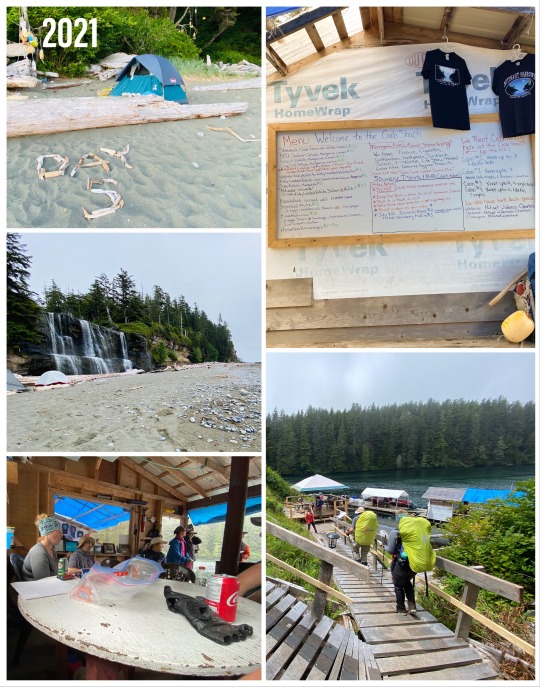
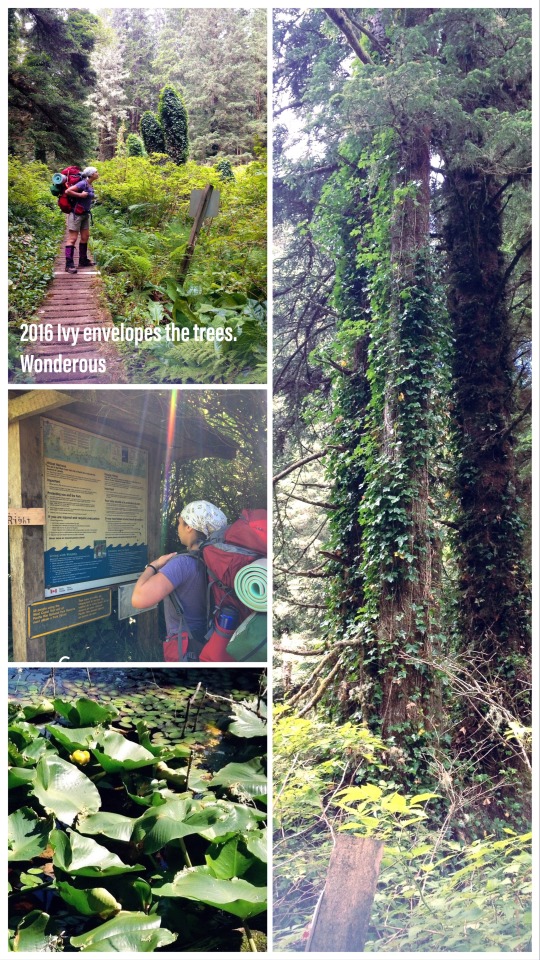
youtube
Tsu-Tsu-Tsusiat!
We left the warming comfort of the Nitinaht stove at about 3pm and headed on our way. We saw our new friend and traveling tag-along Wilson off at the Ditidaht Comfort Camping site and continued on, arriving at Tsusiat Falls by 6:30pm. You can't see the falls from the beach, but if you reach the hole in the wall at Tsusiat Point, you're just minutes away.
In 2016, the first 5 days of our hike Jenna and I had the most amazing weather. On our 5th day, after the crab shack, while the sun beamed a balmy 25+ C, we ditched our packs on a slope of sand with gentler waters between Nitinaht and Tsusiat Point and ran into the ocean up to our knees, jumping the waves and being astonished at their strength. We laid on the beach afterwards and soaked in the sun. When I think of my little sister, I often think of this carefree day and smile. Enjoy the journey as you go, or you’ll miss the best parts.
Tsusiat Falls is a popular campground. When we arrived the beach was packed. According to 2021 Parks regs, you can only stay one night here to minimize environmental impact. The beach was very different from what I remembered, but the falls were ever glorious. We threw on bathing suites and while Krista enjoyed the brief sun, I took a dip in the beckoning water.
The next morning, with Krista not feeling hot, I'd aimed to get up early and walk back to the Hole In The Wall with my Nikon DSLR camera. When we passed by the day before it was high tide and the Hole was under sea water. However, after a delay, Krista decided to come with me. We packed up, left our bags at Tsusiat and strolled back to the hole together, and a better decision it was. I’d watched a group ahead of us pass through an hour ago, but beneath their tracks you could make out a fresh set of cougar prints. Since low tide was at 10am that morning, that means the tracks were very recent and could only have been made since the water receded. Food for thought.
Darling Bears You Might Be Cute, But I Don't Want To Snuggle
The last 2 days on the WCT (or your first two, depending where you start) are the easiest to hike and where you make up the most ground. We'd intended to land at Darling River Campsite (approx km 14), which from Tsusiat (approx km 25) would make it about an 11 km day. Most of our fellow travellers whom we had become familiar with were aiming for Michigan Creek though, which would add 2 km to our 6th day, but save us that on our 7th and final day out. We decided to see what the day held and if we arrived at Darling early we might continue on. WELL.... what the day held was not entirely what we expected.
In 2016 Jenna and I walked the beach hike between Tsocowis Creek and Michigan Creek. It had started to rain the night before and by morning was a light, but steady, downpour. We donned our rain gear but by noon, and halfway through our distance, it was clear that Jenna's rain jacket was not waterproof. Though she had tested it prior to leaving, it turned out not to be up to WCT-level rain. As we continued on poor Jenna got wetter and wetter and by the time we reached Michigan, she was soaked through to the bone. Water pooled in her boots, and she shivered so hard she couldn't help me with the tent. Realizing this could get worse quickly, I popped the tent, got her changed and snugged into her sleeping bag ASAP. Then I worked on adding a tarp. When the shivering stopped we got a warm meal into her and passed our time taking turns winding up our emergency radio and trying to maintain the faint signal from a long forgotten US talk station till darkness fell. It poured the entire next day as well for a total of over 24 hours straight and our photos at the Pacheena lighthouse are in plastic emergency ponchos.
In 2021 Krista and I opted for the inland trail as we'd previously made better time this way. There is lots to see here, another Donkey Engine and a rusty old grader, and I absolutely love the Billy Goat Bridge. The trail threw us for a bit at Tsocowis Creek, there, phantom branch-offs seemed to lead off and abruptly stop. You have to go down the ladders to continue the inland trail portion (OR access the beach). However, just passed Orange Juice Creek, it was quite clear this section of trail was not well used recently... by people anyway. It was eerily dark, overgrown and passed by what looked like long lost abandoned campsites in caves along the rock wall. As we passed by we heard something stir in the dim light, knocking over an old cup, and we nervously quickened our pace. We began to see pile after pile of fresh bear scat, some so fresh that by the time we reached Darling we figured we must be just behind it. Making a lot of noise we made our way to the beach and relief washed over us as we recognized people half a km ahead... our fellow Albertans, Mat and Lauren! But when they stopped suddenly and started to back up we knew something wasn't right.
Just ahead of them on the beach was our bear. And big guy he was! They figured a lone male. They managed to scare him off and once we caught up the 4 of us made our way as a group to Michigan Creek just down the beach where we figured there was relative safety in numbers.
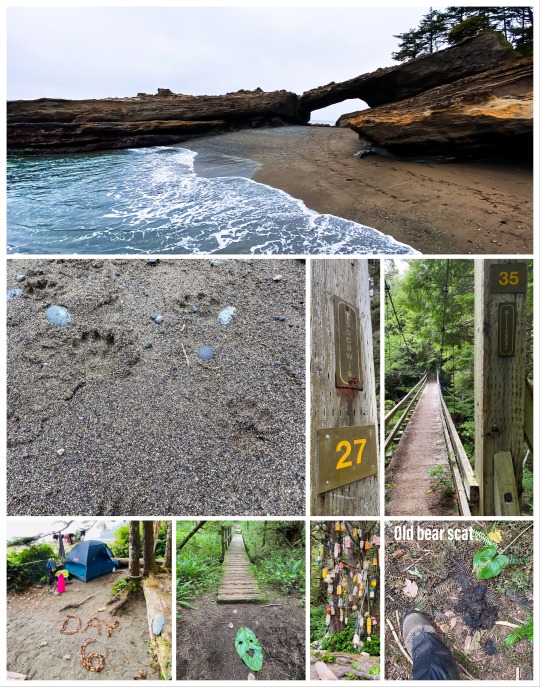
youtube
Bitter Sweet Goodbyes
Our last day from Michigan to the Information Station at Pacheena was a super short one. We were the last hikers to leave Michigan at 8am and among the first ones (ironically) to reach the Parks office at 11:01am. The path is very well maintained and an easy hike. You'll also see a lot of day hikers here, many with dogs. Along the way are some cool sights you won't want to miss, so don't be too quick to rush out. The abandoned dirt bike isn't going anywhere fast anymore, but be sure to check out the sea lion rock just passed km 10. You may even hear them from the trail! Just before the sea lions you'll also pass by the Pacheena Lighthouse. Again, due to covid, you cant access the grounds but you can totally snap a quick pic! The area has so much bear activity Parks Staff joke about running 'bear daycare' here so be vigilant. Two wonderfully enthusiastic young ladies we met along the way carried an amazing tune; Im sure they must've charmed away any "would be" encounters.
In 2016 there was no km 1 sign on the trail and in 2021 there was still no km 1 sign lol. Both times I raced past km 2 and then later wished I'd taken a pic with it. You'll want it as proof! We walked the very last km along the beach, where firm sand makes for easy going. There were bear sightings of a mother and cubs here just before we arrived. We missed them, but were lucky enough to get some great foot-print photos. The very last bench you'll see on the trail is emblazoned with the word 'PARKS'. We sat here for an eternal minute and took some photos. As we strolled towards the Information station I couldn't believe it was over again so quickly.
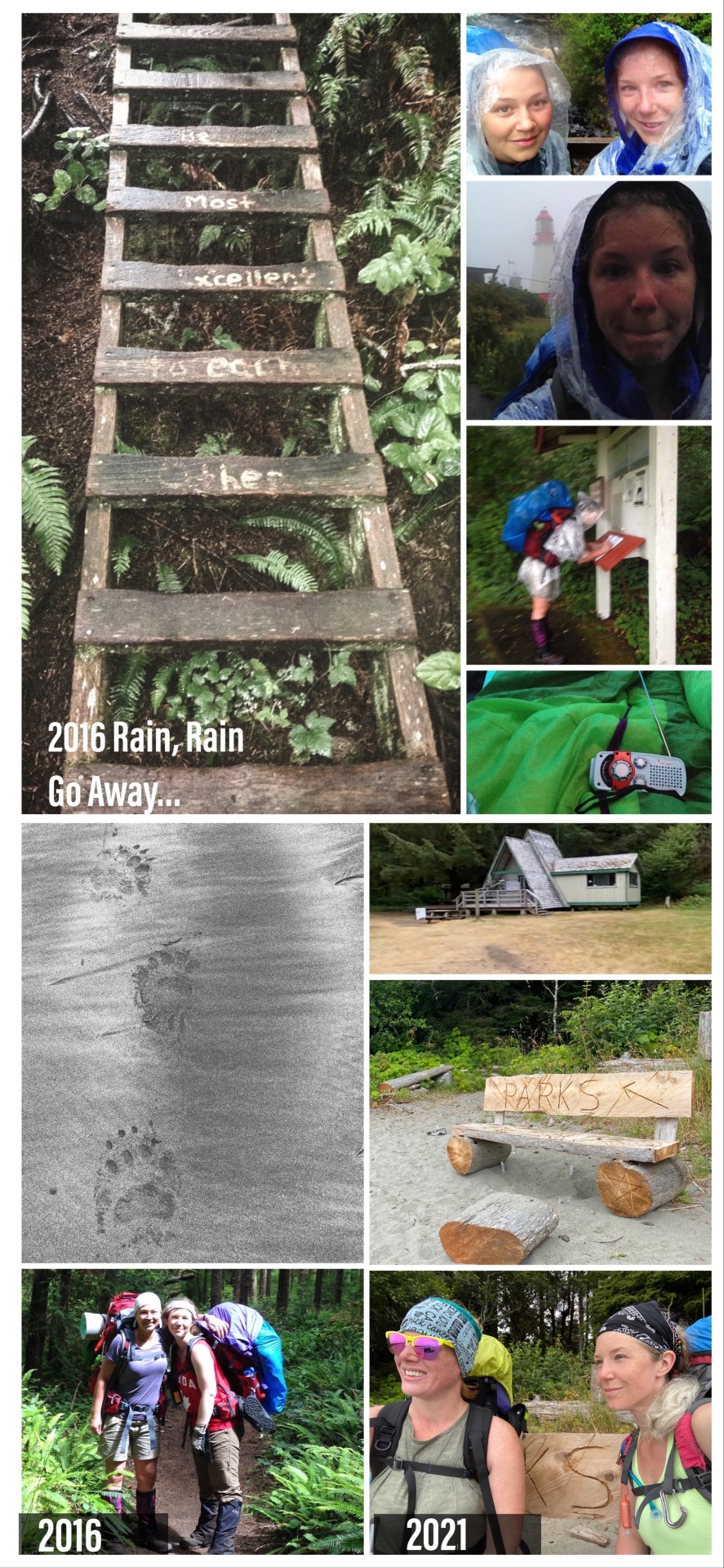
Looking back, even after time number two, it feels more like a dream. The first time I walked off the trail in 2016 I eagerly anticipated a hot shower, was thoroughly disappointed at finding I had no quarters for to pay for one and I spent the 5 hour bus ride home starving and trying to sleep on a roller coaster. Perhaps not such a glorious end, but I realized I had achieved something few people would in their life time and of that I was SO proud of Jenna and myself. We did it.
When I arrived back at work Sharon had the most glorious little bouquet of flowers for me and she glued tiny cut out flags of all the major trail milestones to skewer sticks throughout. It brought tears to my eyes.... she told me this, "for a while, you will think to yourself, I am NEVER going back to that EVER again. And then, slowly, you will forget all the bad parts and the thought will creep in... maybe, perhaps, I might try it again... and you will find yourself looking it up once more". And she was right, I did. And I am so glad I did... I might even do it again.
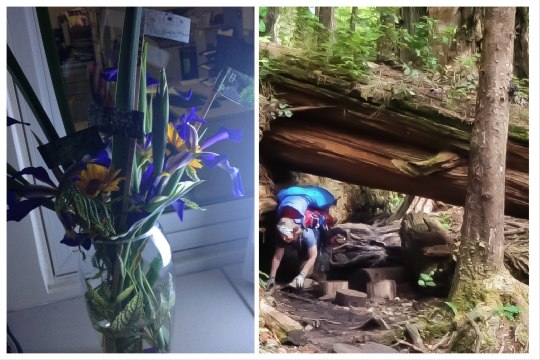
2 notes
·
View notes